-
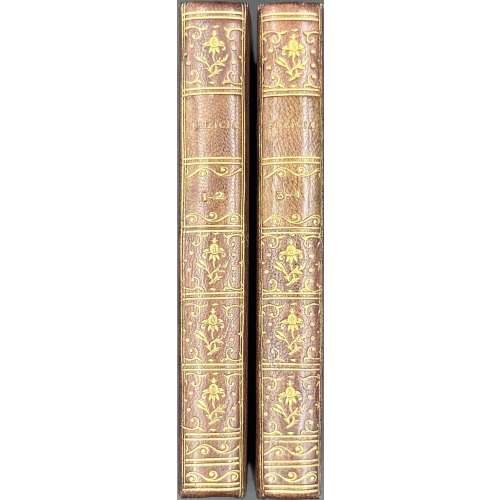 NEWTwo volumes, 135 x 85 mm each, uniformly bound in full brown morocco with triple fillet border, flat spine with gilt fleurons and double fillet bands, gilt lettered label, interior dentelle, marbled endpapers, all edges gilt; four volumes in two, collated in 12mo. Vol. 1: pp.: [1-5] 6-100, coll.: 1-86 92;(i.e. 50 leaves); [1-5] 6-130; coll.: 1-106 115 (i.e. 65 leaves); plus two blanks in the front and at the rear, and nine plates, incl. frontispiece. Vol. 2: pp.: [1-5] 6-111 [112 blank], coll.: 14 2-96 104 (i.e. 56 leaves); [4 ht, tp] [1] 2-99 [100 blank], coll.: π2 1-86 92 (i.e. 52 leaves); plus two blanks in the front and at rear, and four plates. Title-page: FÉLICIA, | OU | MES FREDAINES. | {in rules} La faute en est aux Dieux qui me firent si folle.| TOME PREMIER/ SECOND/ TROISIÉME/ QUATRIÈME. | —•— | A LONDRES | M. DCC. LXXVI. || Catalogue raisonné: Dutel, A-399, p. 132. Contributors: André-Robert Andréa de Nerciat (French, 1739 – 1800) – author.
NEWTwo volumes, 135 x 85 mm each, uniformly bound in full brown morocco with triple fillet border, flat spine with gilt fleurons and double fillet bands, gilt lettered label, interior dentelle, marbled endpapers, all edges gilt; four volumes in two, collated in 12mo. Vol. 1: pp.: [1-5] 6-100, coll.: 1-86 92;(i.e. 50 leaves); [1-5] 6-130; coll.: 1-106 115 (i.e. 65 leaves); plus two blanks in the front and at the rear, and nine plates, incl. frontispiece. Vol. 2: pp.: [1-5] 6-111 [112 blank], coll.: 14 2-96 104 (i.e. 56 leaves); [4 ht, tp] [1] 2-99 [100 blank], coll.: π2 1-86 92 (i.e. 52 leaves); plus two blanks in the front and at rear, and four plates. Title-page: FÉLICIA, | OU | MES FREDAINES. | {in rules} La faute en est aux Dieux qui me firent si folle.| TOME PREMIER/ SECOND/ TROISIÉME/ QUATRIÈME. | —•— | A LONDRES | M. DCC. LXXVI. || Catalogue raisonné: Dutel, A-399, p. 132. Contributors: André-Robert Andréa de Nerciat (French, 1739 – 1800) – author. -
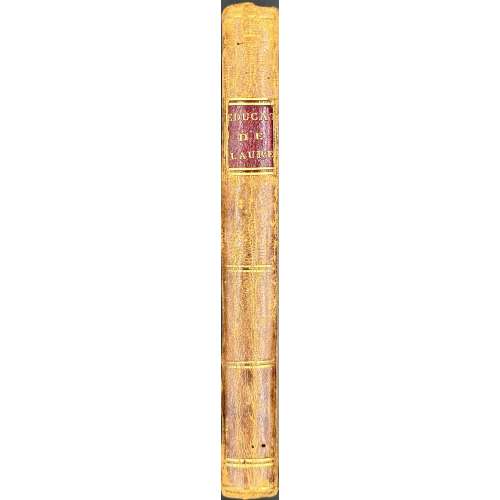 NEWHardcover, 169 x 100 mm, quarter brown sheepskin over speckled paper, flat spine, gilt double fillet bands, crimson morocco label with gilt lettering, printed on French paper watermarked “FIN 1787”; two volumes in one, collated in 12mo. Tome premier: π1 h.t., A8 (A1 t.p., A2,3 Lettre de Sophie au chevalier d'Olzan), B4 C8 D4 E8 F4 G8, H4, I4; pp.: [2] [i-iii] iv-vi, [7] 8-104, plus three plates, p. 24 printed on cream wove paper, pp. 66, 67 on blue laid paper (or pasted on such). Tome second: A8 (incl. h.t. and t.p.) B4 C8 D4 E8 F4 G8 H4 I8 K4, L4; pp.: [1-5] 6-127 [1 blank]; all three plates printed on cream wove paper; plate marked as p.68 is after p. 64, plate marked p.64 is after p. 68, plate p. 79 is on its place. Plates attributed to Louis Binet. Text is attributed mainly to Comte de Mirabeau; however, Guillaume Apollinaire, in his L’Enfer de la Bibliothèque Nationale (1913), believes that Marquis de Sentilly wrote it. Catalogue raisonné: Cohen-de Ricci 709; Dutel I A-988, p. 294. Contributors: Mirabeau, Honoré Gabriel Riqueti, Comte de (French, 1749 – 1791) Binet, Louis (French, 1744 – 1800) Seller's description: Deux parties en un volume in-12. 165 x 97 mm. Tome premier: I f. n. ch. faux-titre, 104 pp. y compris le titre avec une vignette gravée, la "Lettre de Sophie au chevalier d'Olzan" qui débute l'ouvrage est paginée en chiffres romains. Tome second: 127 pp. tout compris et 1 p. bl. 6 gravures libres non signées qui sont de Binet. Reliure de l'époque. Demi-basane brune, plats de papier coquille moucheté, dos lisse omé de deux filets dorés répétés, pièce de titre de maroquin rouge, lettres dorées, tranches jaspées. Reliure un peu frottée, coins émoussés. Quelques rousseurs. Rarissime deuxième édition de cet Émile de l'éducation sexuelle enrichie de gravures libres attribuables à Binet.
NEWHardcover, 169 x 100 mm, quarter brown sheepskin over speckled paper, flat spine, gilt double fillet bands, crimson morocco label with gilt lettering, printed on French paper watermarked “FIN 1787”; two volumes in one, collated in 12mo. Tome premier: π1 h.t., A8 (A1 t.p., A2,3 Lettre de Sophie au chevalier d'Olzan), B4 C8 D4 E8 F4 G8, H4, I4; pp.: [2] [i-iii] iv-vi, [7] 8-104, plus three plates, p. 24 printed on cream wove paper, pp. 66, 67 on blue laid paper (or pasted on such). Tome second: A8 (incl. h.t. and t.p.) B4 C8 D4 E8 F4 G8 H4 I8 K4, L4; pp.: [1-5] 6-127 [1 blank]; all three plates printed on cream wove paper; plate marked as p.68 is after p. 64, plate marked p.64 is after p. 68, plate p. 79 is on its place. Plates attributed to Louis Binet. Text is attributed mainly to Comte de Mirabeau; however, Guillaume Apollinaire, in his L’Enfer de la Bibliothèque Nationale (1913), believes that Marquis de Sentilly wrote it. Catalogue raisonné: Cohen-de Ricci 709; Dutel I A-988, p. 294. Contributors: Mirabeau, Honoré Gabriel Riqueti, Comte de (French, 1749 – 1791) Binet, Louis (French, 1744 – 1800) Seller's description: Deux parties en un volume in-12. 165 x 97 mm. Tome premier: I f. n. ch. faux-titre, 104 pp. y compris le titre avec une vignette gravée, la "Lettre de Sophie au chevalier d'Olzan" qui débute l'ouvrage est paginée en chiffres romains. Tome second: 127 pp. tout compris et 1 p. bl. 6 gravures libres non signées qui sont de Binet. Reliure de l'époque. Demi-basane brune, plats de papier coquille moucheté, dos lisse omé de deux filets dorés répétés, pièce de titre de maroquin rouge, lettres dorées, tranches jaspées. Reliure un peu frottée, coins émoussés. Quelques rousseurs. Rarissime deuxième édition de cet Émile de l'éducation sexuelle enrichie de gravures libres attribuables à Binet. -
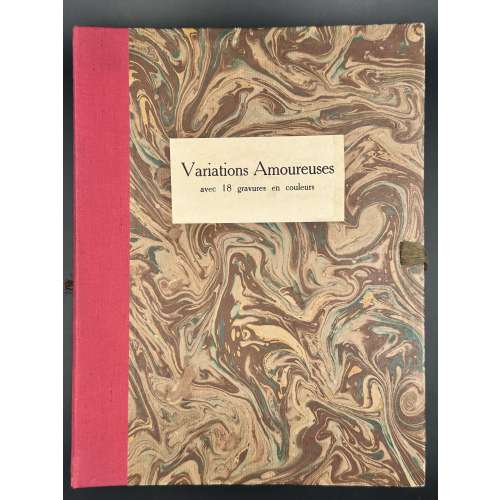 NEWA cardboard file 298 x 225 mm made of quarter red cloth over marbled paper, with laces, contains 18 loose chromolithographs approx.190 x 130 mm, 8 vertical and 10 horizontal) in a passepartout 275 x 220 mm (matted) of laid paper with an armorial watermark, with lewd humorous captions on glassine guard tissue attached to each sheet, upper and outer margins uncut. Images signed “–Santippa–36”.Label to front cover lettered Variations Amoureuses | avec 18 gravures en couleurs ||. No title page. It is quite likely that the set exists in only one copy. Description by seller: Album in-folio, 272 x 218 cm. En feuilles, sous chemise cartonnée à lacets de l'éditeur. Les lithographies sont respectivement intitulées : Branlade; Plaisir Champêtre; Justice; Entre Marins ; Cocher; Suce-moi bien ; Encore; Les Joies; Un Marin; On raconte ; Plaisir Divin ; Le Marin; Quand un Gendarme ; soixante et Neuf; Tous les Moyens ; Le Plus Cochon; Le Fantassin; Coup Double. Le peintre Gaston Hoffmann (1883-1977), consacra la majeure partie de son œuvre à l'érotisme et la caricature, en signant ses sujets trop libres sous le pseudonyme de Santippa. Contributor: Gaston Hoffmann [Santippa] (French, 1883 – 1977). Ref: Honesterotica.com provides only 8 images of 18. Catalogue raisonné: Dutel III: № 2581:
NEWA cardboard file 298 x 225 mm made of quarter red cloth over marbled paper, with laces, contains 18 loose chromolithographs approx.190 x 130 mm, 8 vertical and 10 horizontal) in a passepartout 275 x 220 mm (matted) of laid paper with an armorial watermark, with lewd humorous captions on glassine guard tissue attached to each sheet, upper and outer margins uncut. Images signed “–Santippa–36”.Label to front cover lettered Variations Amoureuses | avec 18 gravures en couleurs ||. No title page. It is quite likely that the set exists in only one copy. Description by seller: Album in-folio, 272 x 218 cm. En feuilles, sous chemise cartonnée à lacets de l'éditeur. Les lithographies sont respectivement intitulées : Branlade; Plaisir Champêtre; Justice; Entre Marins ; Cocher; Suce-moi bien ; Encore; Les Joies; Un Marin; On raconte ; Plaisir Divin ; Le Marin; Quand un Gendarme ; soixante et Neuf; Tous les Moyens ; Le Plus Cochon; Le Fantassin; Coup Double. Le peintre Gaston Hoffmann (1883-1977), consacra la majeure partie de son œuvre à l'érotisme et la caricature, en signant ses sujets trop libres sous le pseudonyme de Santippa. Contributor: Gaston Hoffmann [Santippa] (French, 1883 – 1977). Ref: Honesterotica.com provides only 8 images of 18. Catalogue raisonné: Dutel III: № 2581: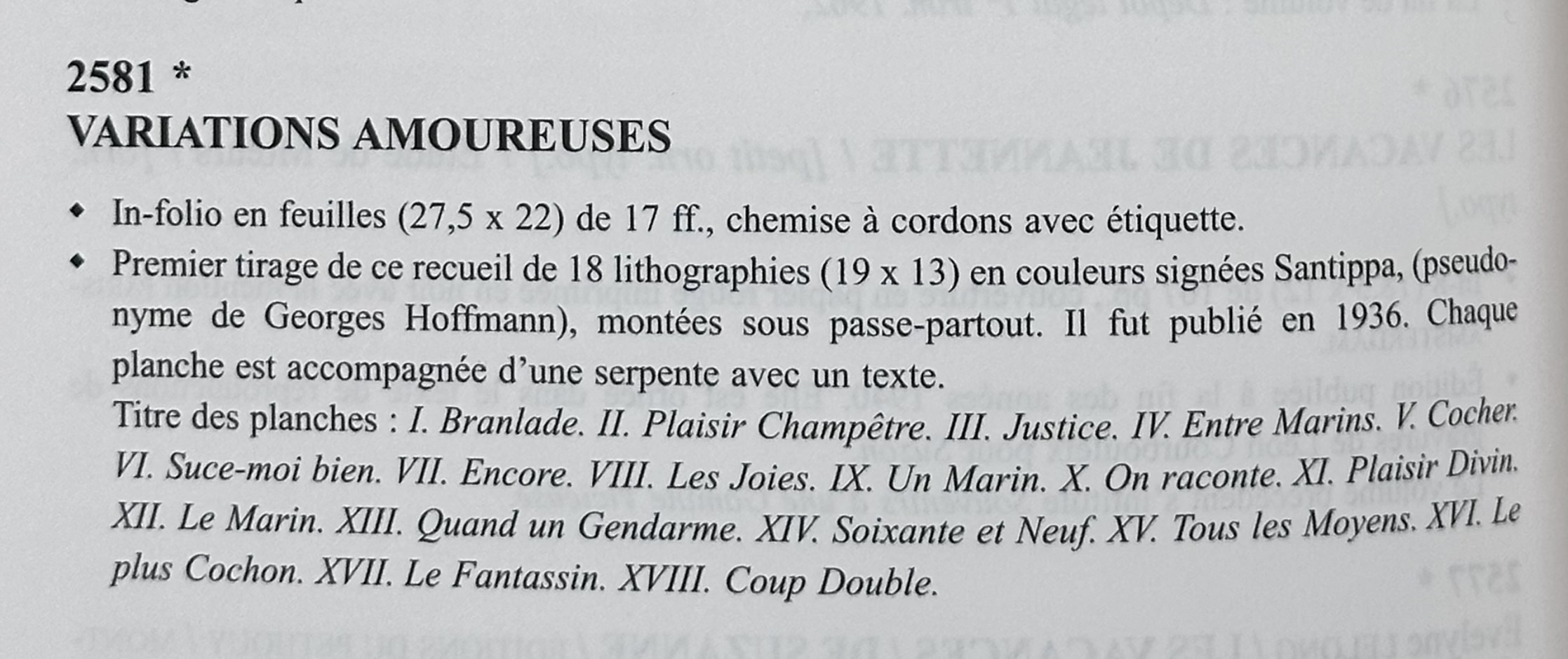
-
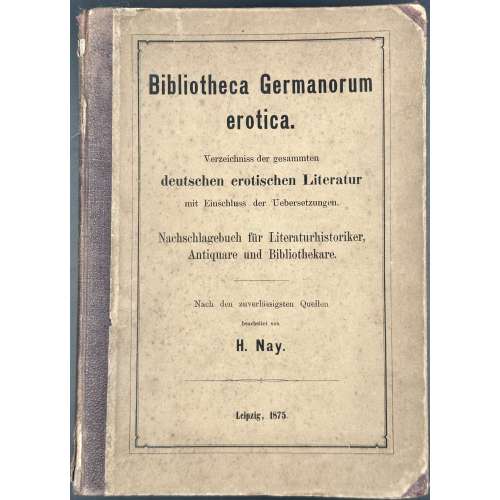 NEWHardcover, 231 x 165 mm, half brown cloth over cardboard, lettering in a frame to front, similar to t.p., pp.: [4] [1] 2-151 [152], collated 4to: π2 1-194, i.e. 78 leaves. Entries are in alphabetic order by name. Title-page (and front cover): Bibliotheca Germanorum | erotica. | Verzeichniss der gesammten | deutschen erotischen Literatur | mit Einschluss der Uebersetzungen. | Nachschlagebuch für Literaturhistoriker, | Antiquare und Bibliothekare. | Nach den zuverlässigsten Quellen | bearbeitet von | H. Nay. | — •— | Leipzig, 1875. || [Bibliotheca Germanorum erotica. List of all German erotic literature, including translations. Reference book for literary historians, antiquarians and librarians. Based on the most reliable sources edited by H. Nay]. Imprint: Druck von E. Rupfer in Stuttgart. Ref: Worldcat. Author: Hugo Hayn [Nay, H.] (German, 1843 – 1923)
NEWHardcover, 231 x 165 mm, half brown cloth over cardboard, lettering in a frame to front, similar to t.p., pp.: [4] [1] 2-151 [152], collated 4to: π2 1-194, i.e. 78 leaves. Entries are in alphabetic order by name. Title-page (and front cover): Bibliotheca Germanorum | erotica. | Verzeichniss der gesammten | deutschen erotischen Literatur | mit Einschluss der Uebersetzungen. | Nachschlagebuch für Literaturhistoriker, | Antiquare und Bibliothekare. | Nach den zuverlässigsten Quellen | bearbeitet von | H. Nay. | — •— | Leipzig, 1875. || [Bibliotheca Germanorum erotica. List of all German erotic literature, including translations. Reference book for literary historians, antiquarians and librarians. Based on the most reliable sources edited by H. Nay]. Imprint: Druck von E. Rupfer in Stuttgart. Ref: Worldcat. Author: Hugo Hayn [Nay, H.] (German, 1843 – 1923) -
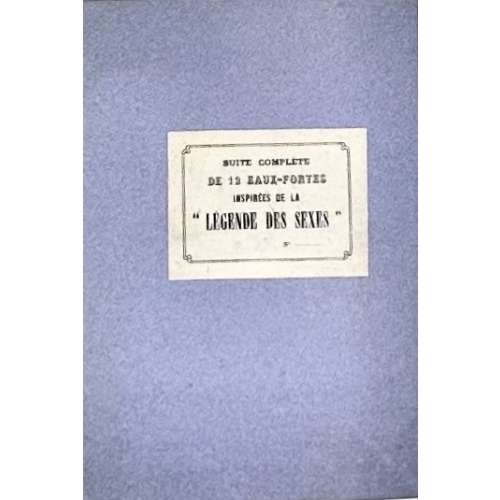 NEWTwelve etchings printed in black on laid paper, uncoloured, sheet 236 x 140 mm, platemark 155 x 100 mm, red ink stamp “ARS EROTICA | Hans-J. Döpp” to verso; image title in pencil to recto of some sheets. Pale ‘remarque’ on the lower margin of plate 2 ‘L’Eden’. Traces of original binding along the right edge. No folder. Catalogue raisonné: Luc Binet 2017: 100-B, pp. 639-51 ; S. A. Perry 2015: 80, p. 70-1.
NEWTwelve etchings printed in black on laid paper, uncoloured, sheet 236 x 140 mm, platemark 155 x 100 mm, red ink stamp “ARS EROTICA | Hans-J. Döpp” to verso; image title in pencil to recto of some sheets. Pale ‘remarque’ on the lower margin of plate 2 ‘L’Eden’. Traces of original binding along the right edge. No folder. Catalogue raisonné: Luc Binet 2017: 100-B, pp. 639-51 ; S. A. Perry 2015: 80, p. 70-1.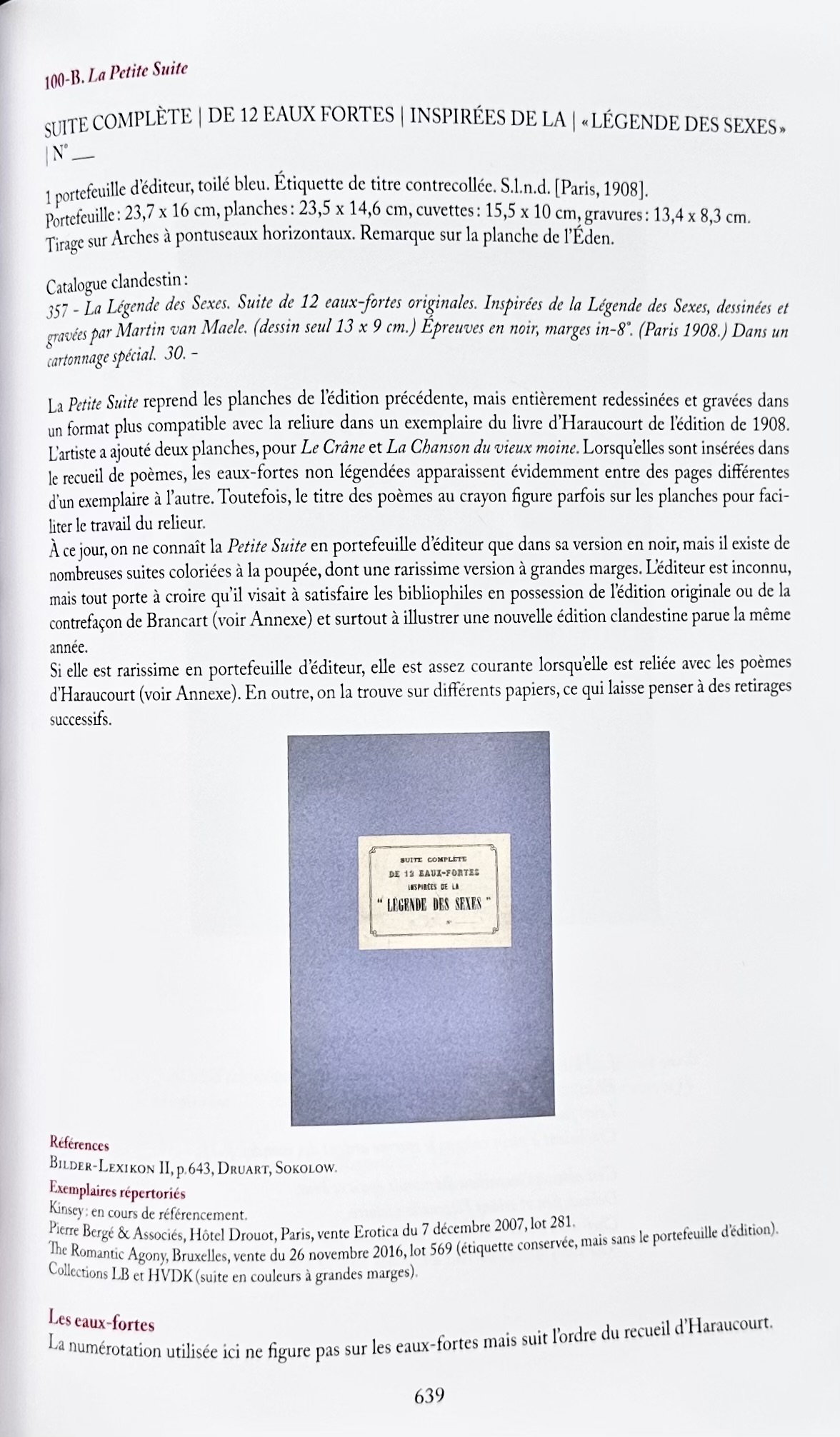 List of images:
List of images:
- Le Coït des Atomes
- L’Éden
- La Flûte
- Portes d’enfer
- Danaë
- L’obsession
- Europe
- Le crâne
- Mélancolie blennorhagique [sic]
- Parisienne
- La chanson du vieux moine
- Reine du monde
-
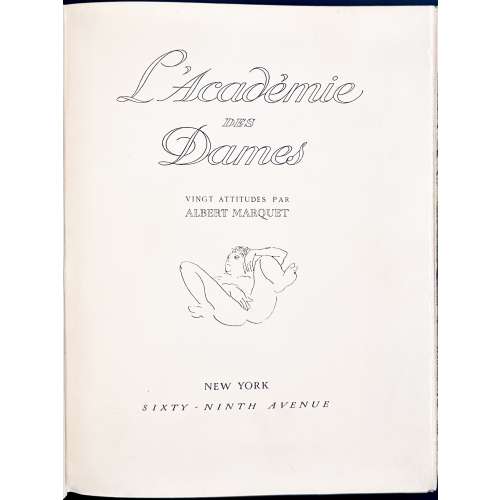 NEWHardcover, 330 x 255 mm, marble paper, two labels of black calf with gilt lettering to spine, 2 blank leaves at front and 2 at back (laid paper), two leaves of lithographic vignettes (t.p. and limitation), plus 20 lithographic plates signed “am”, unpaginated. Limited edition of 25 copies on Japon Impérial paper №№ 1-25, 300 copies on Vélin d’Arches №№ 26-325, of which this is copy № 206. Stones sanded. A poem by Verlaine at p. 2 recto. Title-page: L'Académie | DES | Dames | VINGT ATTITUDES PAR | ALBERT MARQUET | {vignette} | NEW YORK | SIXTY-NINTH AVENUE || Imprint: ÉDITION PRIVÉE | EXEMPLAIRE NUMERO 206 Limitation: JUSTIFICATION DU TIRAGE | IL A ÉTÉ TIRÉ DE CET OUVRAGE | VINGT-CINQ EXEMPLAIRES SUR JAPON IMPÉRIAL | NUMÉROTÉS DE 1 à 25 | ET TROIS CENTS EXEMPLAIRES SUR VÉLIN D'ARCHES | NUMÉROTÉS DE 26 à 325 | PIERRES BIFFÉES || Catalogue raisonné: Dutel III № 949; Nordmann I № 255. Provenance: From the collection of Hans-Jürgen Döpp, Frankfurt. Contributors: Albert Marquet (French, 1875 – 1947) Verlaine, Paul (French, 1844 – 1896) One additional lithographic plate by Marquet from a different source but on a similar subject is laid in.
NEWHardcover, 330 x 255 mm, marble paper, two labels of black calf with gilt lettering to spine, 2 blank leaves at front and 2 at back (laid paper), two leaves of lithographic vignettes (t.p. and limitation), plus 20 lithographic plates signed “am”, unpaginated. Limited edition of 25 copies on Japon Impérial paper №№ 1-25, 300 copies on Vélin d’Arches №№ 26-325, of which this is copy № 206. Stones sanded. A poem by Verlaine at p. 2 recto. Title-page: L'Académie | DES | Dames | VINGT ATTITUDES PAR | ALBERT MARQUET | {vignette} | NEW YORK | SIXTY-NINTH AVENUE || Imprint: ÉDITION PRIVÉE | EXEMPLAIRE NUMERO 206 Limitation: JUSTIFICATION DU TIRAGE | IL A ÉTÉ TIRÉ DE CET OUVRAGE | VINGT-CINQ EXEMPLAIRES SUR JAPON IMPÉRIAL | NUMÉROTÉS DE 1 à 25 | ET TROIS CENTS EXEMPLAIRES SUR VÉLIN D'ARCHES | NUMÉROTÉS DE 26 à 325 | PIERRES BIFFÉES || Catalogue raisonné: Dutel III № 949; Nordmann I № 255. Provenance: From the collection of Hans-Jürgen Döpp, Frankfurt. Contributors: Albert Marquet (French, 1875 – 1947) Verlaine, Paul (French, 1844 – 1896) One additional lithographic plate by Marquet from a different source but on a similar subject is laid in.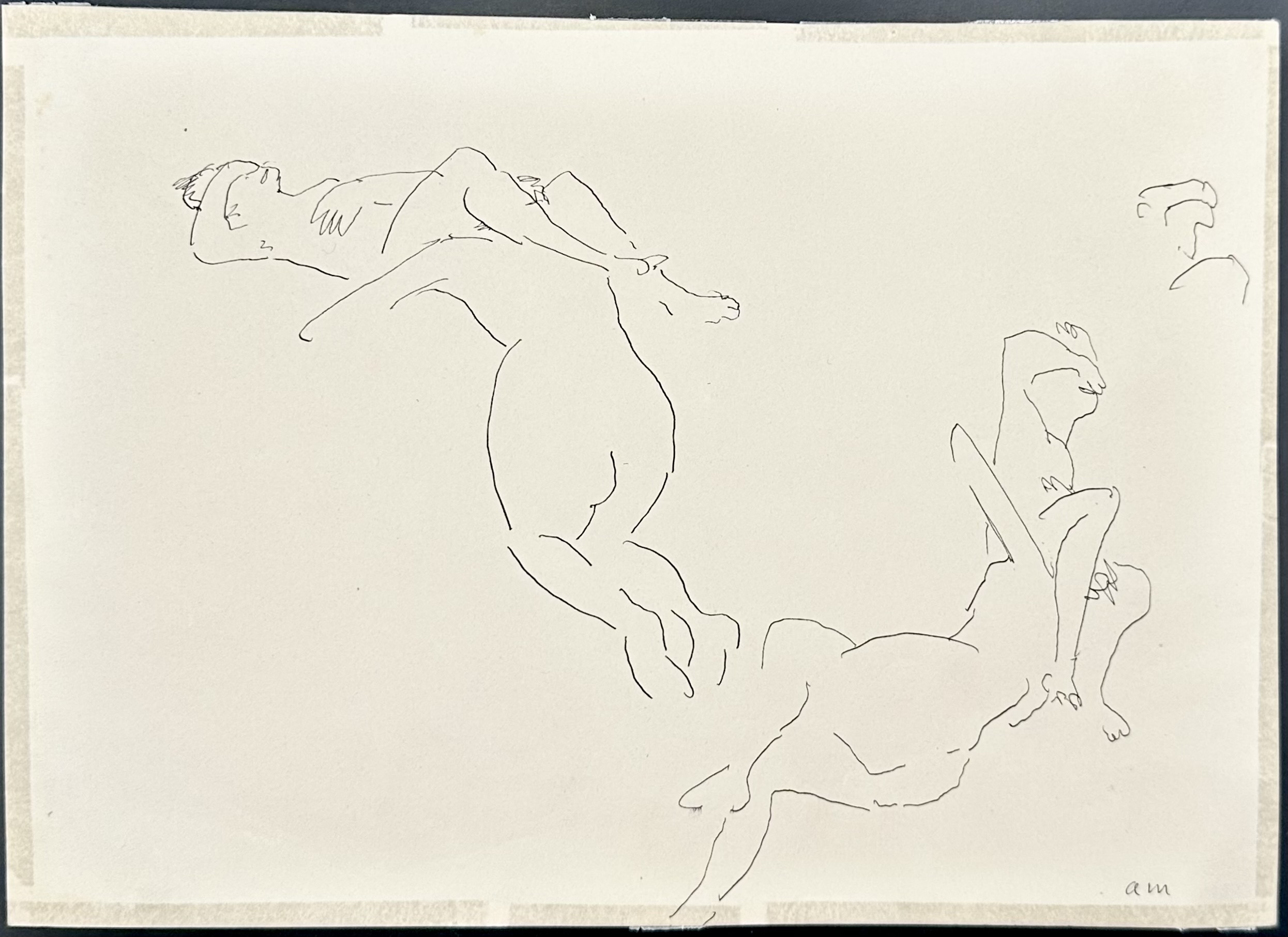
-
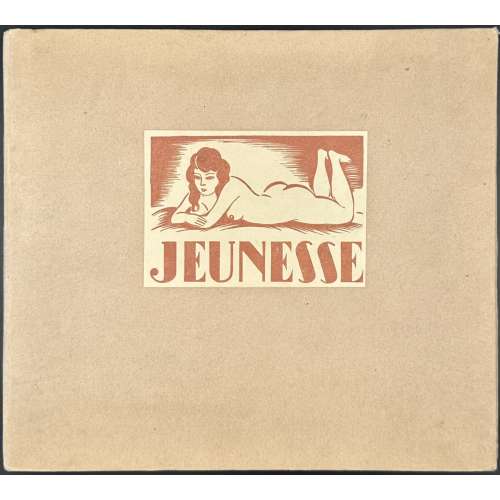 NEWCardboard folder with title label to front, 23.5 x 26.3 cm, containing 12 hand-coloured soft-ground etchings by André Collot, unbound, in a paper folder with pink lettering and vignette engraved on wood, with a title-page in black: JEUNESSE | 12 VERNIS MOUS COLORIÉS | tires à exemplaires | réservés aux Amis de l’Artiste | 1933 || in a frame. First edition, limited to 60 copies. Dutel 1920-70: 1786. There is another copy of the same without the cardboard folder SVE-0469.2021.
NEWCardboard folder with title label to front, 23.5 x 26.3 cm, containing 12 hand-coloured soft-ground etchings by André Collot, unbound, in a paper folder with pink lettering and vignette engraved on wood, with a title-page in black: JEUNESSE | 12 VERNIS MOUS COLORIÉS | tires à exemplaires | réservés aux Amis de l’Artiste | 1933 || in a frame. First edition, limited to 60 copies. Dutel 1920-70: 1786. There is another copy of the same without the cardboard folder SVE-0469.2021. -
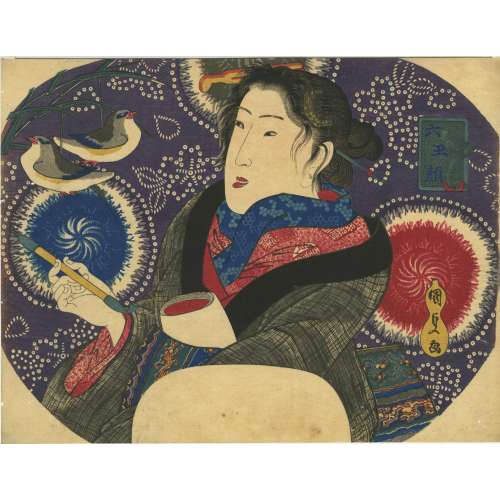 NEWArtist: Utagawa Kunisada [歌川 国貞], a.k.a. Utagawa Toyokuni III [三代 歌川 豊国] (Japanese, 1786 – 1865). Signed: Toyokuni ga [豊国 画] in a yellow double-gourd. Publisher unknown. Media: Untrimmed fan print (uchiwa-e), 228 x 298 mm. Series title: Six Jewel Faces (六玉颜, mu tama-gao), a pun on Six Jewel Rivers (六玉河, Mu Tamagawa). The date seal and censor seal are absent. Another print from the same series in the Metropolitan Museum of New York reads:
NEWArtist: Utagawa Kunisada [歌川 国貞], a.k.a. Utagawa Toyokuni III [三代 歌川 豊国] (Japanese, 1786 – 1865). Signed: Toyokuni ga [豊国 画] in a yellow double-gourd. Publisher unknown. Media: Untrimmed fan print (uchiwa-e), 228 x 298 mm. Series title: Six Jewel Faces (六玉颜, mu tama-gao), a pun on Six Jewel Rivers (六玉河, Mu Tamagawa). The date seal and censor seal are absent. Another print from the same series in the Metropolitan Museum of New York reads:The colorful background, with explosions of tie-dyed floral motifs, is a reminder of how Kunisada made all his thousands of Genji-print designs a visual record of different textile patterns of the day. The title Six Jewel Faces (Mu tama-gao), along with its allusion to the literary theme of Six Jewel Rivers, suggests that this set of fan prints captures the appearance of a half-dozen attractive individuals, and, indeed, the other five works in the set show images of beautiful women, mostly courtesans of the pleasure quarters.
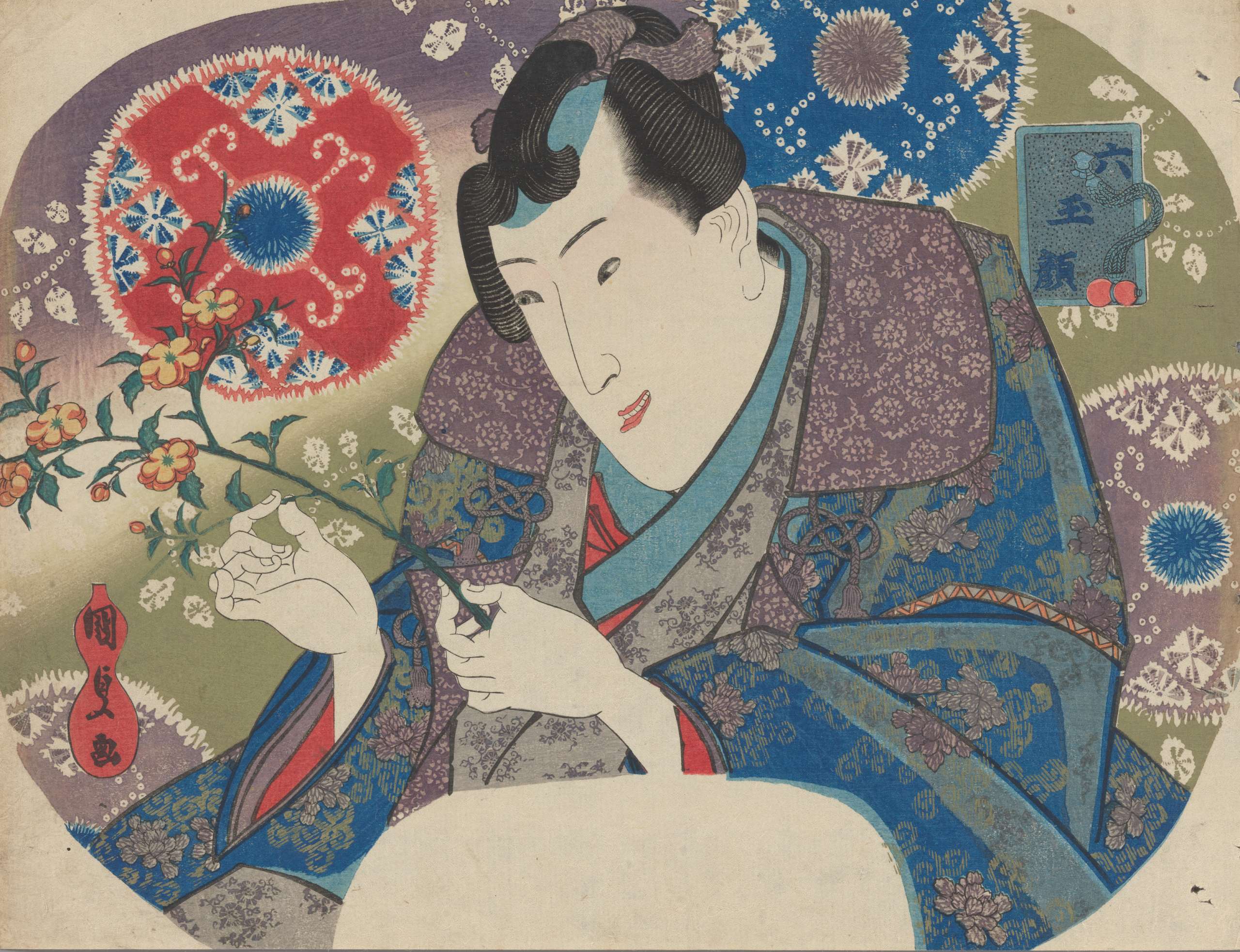 Mitsuuji with Mountain Roses (Yamabuki), from the series “Six Jewel Faces” (Mu tama-gao).
MET Accession Number:2019.3
Ref.: [LIB-2967.2022] Utagawa Kunisada: His world revisited / Catalogue 17, Exhibition March 17-21, 2021. — NY: Sebastian Izzard, LLC., 2021.
Mitsuuji with Mountain Roses (Yamabuki), from the series “Six Jewel Faces” (Mu tama-gao).
MET Accession Number:2019.3
Ref.: [LIB-2967.2022] Utagawa Kunisada: His world revisited / Catalogue 17, Exhibition March 17-21, 2021. — NY: Sebastian Izzard, LLC., 2021. -
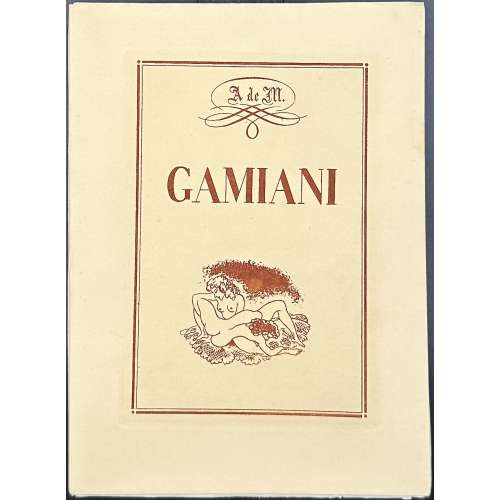 Softcover volume 200 x 145 mm, in a slipcase, unbound, in French wrappers, sanguine lettering on cream paper, block printed on wove paper with watermark “Marais”, collated 8vo, pp.: [1-6] 7-114 [6], 60 leaves, first and last leaves blank; illustrated with 20 etchings, incl. vignette on front wrapper, two head- and two tailpieces, printed in sanguine; etching on t.p., similar to the one on the front wrapper, printed in black. Limited edition of 250 copies, this is copy № 24. Front wrapper and title-page: in a double frame A de M. | GAMIANI | {vignette} || Colophon: CE LIVRE | IMPRIMÉ AUX DÉPENS | D'UN GROUP D'AMATEURS | SUR PAPIER CHIFFON | A ÉTÉ TIRE | A DEUX CENT CINQUANTE EXEMPLAIRES | LA VENTE AU PUBLIC | EN EST RIGOUREUSEMENT INTERDITE | EXEMPLAIRE N°24 || [This book is printed at the expense of a group of amateurs on rag paper in two hundred and fifty copies; sale to the public is strictly prohibited]. Catalogue raisonné: Dutel III № 1649. Alfred de Musset (French, 1810 – 1857) – author.
Softcover volume 200 x 145 mm, in a slipcase, unbound, in French wrappers, sanguine lettering on cream paper, block printed on wove paper with watermark “Marais”, collated 8vo, pp.: [1-6] 7-114 [6], 60 leaves, first and last leaves blank; illustrated with 20 etchings, incl. vignette on front wrapper, two head- and two tailpieces, printed in sanguine; etching on t.p., similar to the one on the front wrapper, printed in black. Limited edition of 250 copies, this is copy № 24. Front wrapper and title-page: in a double frame A de M. | GAMIANI | {vignette} || Colophon: CE LIVRE | IMPRIMÉ AUX DÉPENS | D'UN GROUP D'AMATEURS | SUR PAPIER CHIFFON | A ÉTÉ TIRE | A DEUX CENT CINQUANTE EXEMPLAIRES | LA VENTE AU PUBLIC | EN EST RIGOUREUSEMENT INTERDITE | EXEMPLAIRE N°24 || [This book is printed at the expense of a group of amateurs on rag paper in two hundred and fifty copies; sale to the public is strictly prohibited]. Catalogue raisonné: Dutel III № 1649. Alfred de Musset (French, 1810 – 1857) – author. -
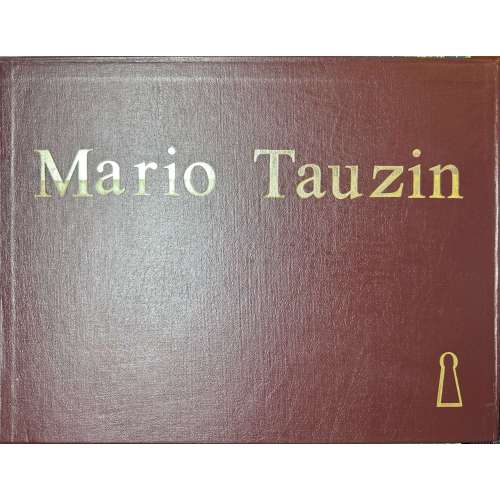 Set of 30 lithographic plates printed on watermarked Van Gelder Simili Japon wove paper, loose in two rexine-backed stiff paper wrappers, 15 in each, together in rexine portfolio with gilt lettering and keyhole on front cover. According to the seller, these are facsimiles of prints/ drawings by Mario Tauzin. Scenes from the series 'Interdit aux adultes'. No publisher indicated; printed in about 1950—a limited edition. Six of these designs used to illustrate 'Bonne à tout faire' were published by Éric Losfeld in the late 1950s (LIB-3293.2024). Dimensions: sheet 320 x 420 mm; album 330 x 430 mm. Contributor: Mario Tauzin (French, 1909 – 1979) — artist
Set of 30 lithographic plates printed on watermarked Van Gelder Simili Japon wove paper, loose in two rexine-backed stiff paper wrappers, 15 in each, together in rexine portfolio with gilt lettering and keyhole on front cover. According to the seller, these are facsimiles of prints/ drawings by Mario Tauzin. Scenes from the series 'Interdit aux adultes'. No publisher indicated; printed in about 1950—a limited edition. Six of these designs used to illustrate 'Bonne à tout faire' were published by Éric Losfeld in the late 1950s (LIB-3293.2024). Dimensions: sheet 320 x 420 mm; album 330 x 430 mm. Contributor: Mario Tauzin (French, 1909 – 1979) — artist -
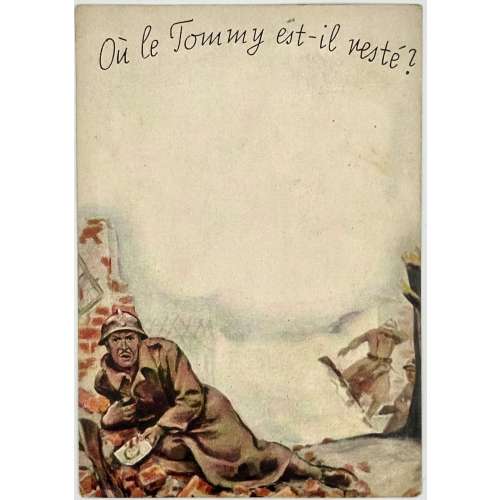 One of a series of six anti-allies propaganda cards, printed in colour, inscribed Ou le Tommy est-il resté? (Where did Tommy stay?), where Tommy is slang for a common soldier in the British Army. The postcards visibly depict French soldiers who fight and die at the western front, while the covert watermark image shows a British military having fun in a bordello. Those cards were printed in the Third Reich for France and dropped from aeroplanes to motivate French soldiers to fight against the British. Size: 149 x 104 mm
One of a series of six anti-allies propaganda cards, printed in colour, inscribed Ou le Tommy est-il resté? (Where did Tommy stay?), where Tommy is slang for a common soldier in the British Army. The postcards visibly depict French soldiers who fight and die at the western front, while the covert watermark image shows a British military having fun in a bordello. Those cards were printed in the Third Reich for France and dropped from aeroplanes to motivate French soldiers to fight against the British. Size: 149 x 104 mm -
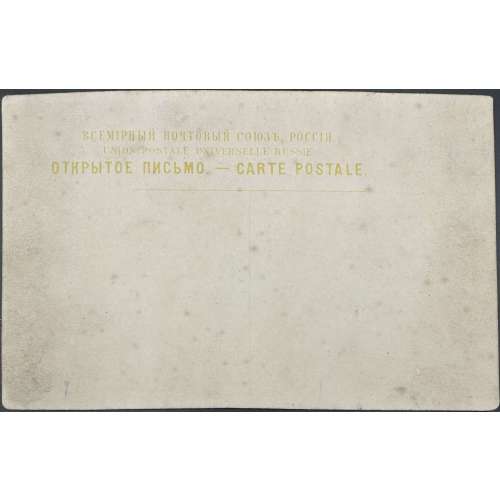 Ten postcards 90 x 140 mm, text in yellow "ВСЕМIРНЫЙ ПОЧТОВЫЙ СОЮЗЪ. РОССIЯ. | UNION POSTALE UNIVERSELLE RUSSIE. | ОТКРЫТОЕ ПИСЬМО. — CARTE POSTALE. || On the reverse, a blue ink woodcut image is printed in the upper left corner, and a blue ink numbered image title is in the bottom centre. Holding the postcard against the backlight reveals a hidden image of an indecent nature (erotic). The use of Latin characters "R" and "N" instead of Russian "Р" and "Н" suggests that the cards were produced in Europe, probably in France. Inscriptions: 1. ПЕRВЫЕ ДNИ; 2. ПОRА ЛЮБВИ; 3. ВЪ ЛЮДИ; 4. КЪ "СВОБОДNОМУ ИСКУССТВУ"; 5. "СВОБОДNЫЙ ТRУДЪ; 6. БЕЗЪ ГОRЯ И ПЕЧАЛИ; 7. NАЗАДЪ КЪ "СВОБОДNОЙ ЛЮБВИ"; 8. ВСЕ ЧТО ОСТАЛОСЬ!; 9. БЕЗЪ КRОВА И ПRИСТАNИЩА; 10. ИЗЪ ЗА ХЛѢБА.
Ten postcards 90 x 140 mm, text in yellow "ВСЕМIРНЫЙ ПОЧТОВЫЙ СОЮЗЪ. РОССIЯ. | UNION POSTALE UNIVERSELLE RUSSIE. | ОТКРЫТОЕ ПИСЬМО. — CARTE POSTALE. || On the reverse, a blue ink woodcut image is printed in the upper left corner, and a blue ink numbered image title is in the bottom centre. Holding the postcard against the backlight reveals a hidden image of an indecent nature (erotic). The use of Latin characters "R" and "N" instead of Russian "Р" and "Н" suggests that the cards were produced in Europe, probably in France. Inscriptions: 1. ПЕRВЫЕ ДNИ; 2. ПОRА ЛЮБВИ; 3. ВЪ ЛЮДИ; 4. КЪ "СВОБОДNОМУ ИСКУССТВУ"; 5. "СВОБОДNЫЙ ТRУДЪ; 6. БЕЗЪ ГОRЯ И ПЕЧАЛИ; 7. NАЗАДЪ КЪ "СВОБОДNОЙ ЛЮБВИ"; 8. ВСЕ ЧТО ОСТАЛОСЬ!; 9. БЕЗЪ КRОВА И ПRИСТАNИЩА; 10. ИЗЪ ЗА ХЛѢБА. -
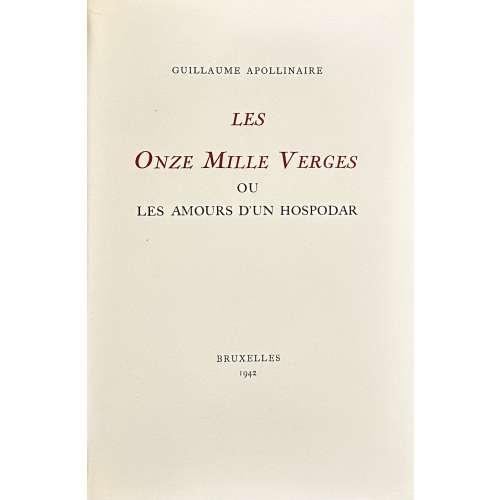 Softcover, 257 x 168 mm, publisher’s cream French flapped wrappers with red lettering to front in a beige double slipcase, printed on wove paper watermarked “Marais” in italic script; edges untrimmed; pp.: [8] [2] [1] 2-130 [131] [3]; collated 4to as 184, 72 leaves incl. those in the wrappers, plus 9 photomechanical stencil-coloured plates extraneous to collation and 9 b/w headpieces (in-text etchings) after anonymous artist. According to the seller and J.-P. Dutel: “In-8 of 130 pages... Illustrated with 10 full-page in colour and some headbands. Limited edition of 500 copies on vélin du Marais". Title-page (red and black): GUILLAUME APOLLINAIRE | LES | ONZE MILLE VERGES | OU | LES AMOURS D'UN HOSPODAR | BRUXELLES | 1942 || Limitation: Il a été tiré de cet ouvrage réservé uniquement aux souscripteurs particuliers 500 exemplaires tous sur vélin du marais. Exemplaire n° 147. Edition: The clandestine edition on vélin de Marais paper limited to 500 copies for subscribers only; this copy is № 147. Catalogue raisonné: Dutel III № 2109. In my copy, similarly to the one of STEVE M., it is only 9 colour plates, while Dutel sites 10. Author: Guillaume Apollinaire (French, 1880 – 1918). Micro photo of a colour plate:
Softcover, 257 x 168 mm, publisher’s cream French flapped wrappers with red lettering to front in a beige double slipcase, printed on wove paper watermarked “Marais” in italic script; edges untrimmed; pp.: [8] [2] [1] 2-130 [131] [3]; collated 4to as 184, 72 leaves incl. those in the wrappers, plus 9 photomechanical stencil-coloured plates extraneous to collation and 9 b/w headpieces (in-text etchings) after anonymous artist. According to the seller and J.-P. Dutel: “In-8 of 130 pages... Illustrated with 10 full-page in colour and some headbands. Limited edition of 500 copies on vélin du Marais". Title-page (red and black): GUILLAUME APOLLINAIRE | LES | ONZE MILLE VERGES | OU | LES AMOURS D'UN HOSPODAR | BRUXELLES | 1942 || Limitation: Il a été tiré de cet ouvrage réservé uniquement aux souscripteurs particuliers 500 exemplaires tous sur vélin du marais. Exemplaire n° 147. Edition: The clandestine edition on vélin de Marais paper limited to 500 copies for subscribers only; this copy is № 147. Catalogue raisonné: Dutel III № 2109. In my copy, similarly to the one of STEVE M., it is only 9 colour plates, while Dutel sites 10. Author: Guillaume Apollinaire (French, 1880 – 1918). Micro photo of a colour plate: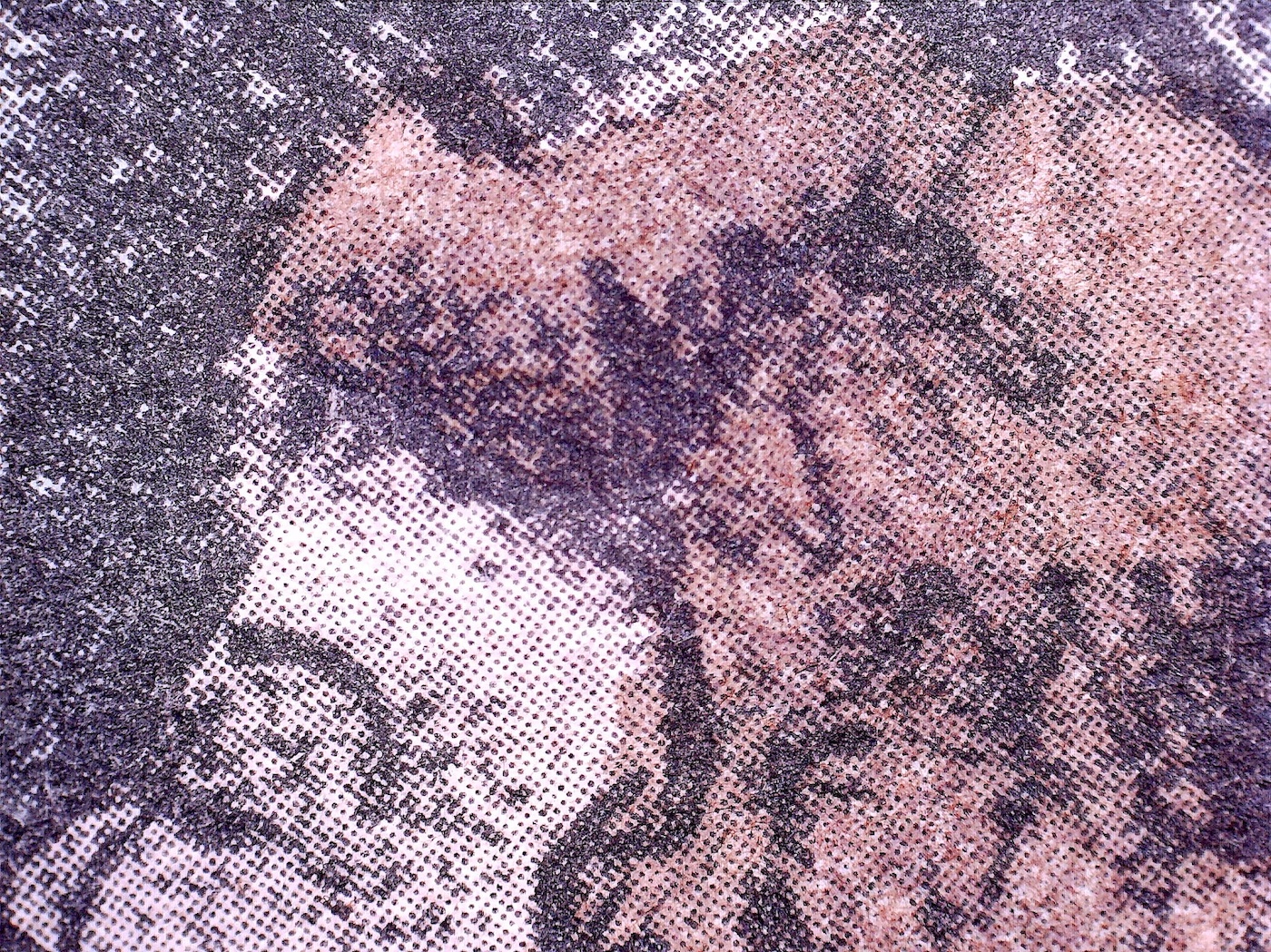 Micro photo of an etching:
Micro photo of an etching:
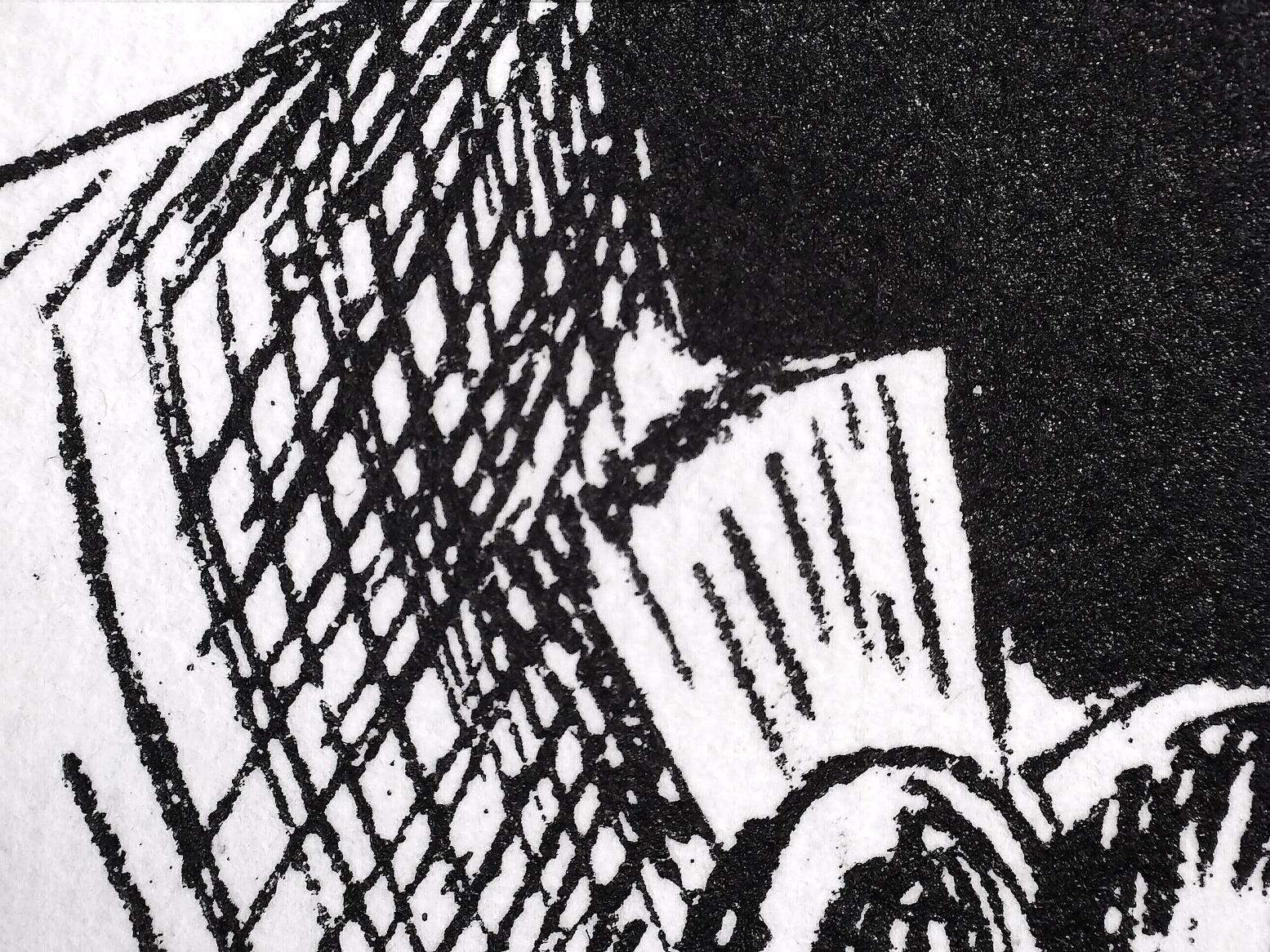
-
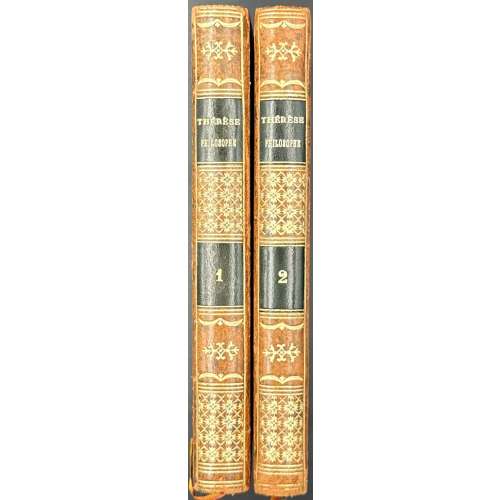 Two volumes, 168 x 106 mm each, uniformly bound in faux mottled calf ruled in gilt, marbled endpapers. Vol. 1: 3 blank leaves of wove paper, 3 blank leaves of laid paper, half-title/blank, blank/frontispiece, ‘engraved’ t.p./blank, both printed on laid paper watermarked “ARCHES A LA | MAIN”; ‘letterpress’ t.p.,/blank, pp.: [1] 2-115 [116 blank], 3 blank leaves of laid paper, 3 blank leaves of wove paper; collated 12mo: π2 A-I6 K4; total 60 leaves plus 16 ‘engraved’ plates, incl. t.p. and frontis. Vol. 2: 3 blank leaves of wove paper, 3 blank leaves of laid paper, half-title/blank, blank/frontispiece, ‘engraved’ t.p./blank, no watermark, ‘letterpress’ t.p.,/blank, pp.: 1-77 [78 blank], 2 blank leaves of laid paper, 3 blank leaves of wove paper; collated 12mo: π2 A-F6 G3; total 41 leaves plus 24 ‘engraved’ plates, incl. t.p. and frontis. Dutel (I): A-1089, p. 325: in-8 (probably by size only, no formula suggested), pagination 115 and 77 as here, 2 frontispieces, 2 engraved titles dated 1873, “et 36 belles gravures de Binet”. Cohen-DeRicci: p. 734 bottom: in-12, no pagination, no formula. "Thérèse" was offered by a French seller user-75d14f4 on the online auction platform CATAWIKI in December 2021. The seller's description of this two-volume set was: "Re-edition, the date of which I was unable to determine. (London, no name, 1782) 2 duodecimo volumes of 115 and 77 pp., very lovely marbled sheepskin pastiche bindings, gilded triple fillets, adorned spines, black title labels. This classic of 18th-century clandestine erotica was written in 1748 by an author who has remained anonymous, attributed at the time to Montigny, which led to his internment in the Bastille. It is now attributed to the Jean-Baptiste de Boyer, Marquis d'Argens. Edition illustrated with 37 very unrestrained figures, engraved in intaglio after Borel, unsigned." I should have paid more attention to the first phase, about the re-edition, but I didn't. After a few bidding rounds, I won the book when the hammer price was 2,200 Euros. On the 28th of December, 2021, I paid for this little beauty $2,760. The book arrived a few days later. The paper's quality and texture, the watermark, the absence of the platemark, and the lack of embossing on the back (text and plates) made me suspect it was a fake. The pages were absolutely flat to the touch! I established clear evidence of a high-resolution 'xerox' copy using Celestron Micro Capture Pro micro-photography. I wrote to the seller and the auction platform, explaining my doubts regarding its authenticity. To prove my point, I include a few micro photos of the "Thérèse" and some books printed at the end of the 18th century. I explained why I considered it a fake and requested a return/refund. After two months of email exchanges, the seller and the platform refused to pay me back. Today is the 2nd anniversary of the purchase. I still have the book. To celebrate my carelessness, I included it in my library to warn fellow book collectors about buying from an unknown dealer via certain online auction platforms. Ref.: Bamber Gascoigne. How to Identify Prints: A Complete Guide to Manual and Mechanical Processes from Woodcut to Ink. — Thames and Hudson, 1995.
Two volumes, 168 x 106 mm each, uniformly bound in faux mottled calf ruled in gilt, marbled endpapers. Vol. 1: 3 blank leaves of wove paper, 3 blank leaves of laid paper, half-title/blank, blank/frontispiece, ‘engraved’ t.p./blank, both printed on laid paper watermarked “ARCHES A LA | MAIN”; ‘letterpress’ t.p.,/blank, pp.: [1] 2-115 [116 blank], 3 blank leaves of laid paper, 3 blank leaves of wove paper; collated 12mo: π2 A-I6 K4; total 60 leaves plus 16 ‘engraved’ plates, incl. t.p. and frontis. Vol. 2: 3 blank leaves of wove paper, 3 blank leaves of laid paper, half-title/blank, blank/frontispiece, ‘engraved’ t.p./blank, no watermark, ‘letterpress’ t.p.,/blank, pp.: 1-77 [78 blank], 2 blank leaves of laid paper, 3 blank leaves of wove paper; collated 12mo: π2 A-F6 G3; total 41 leaves plus 24 ‘engraved’ plates, incl. t.p. and frontis. Dutel (I): A-1089, p. 325: in-8 (probably by size only, no formula suggested), pagination 115 and 77 as here, 2 frontispieces, 2 engraved titles dated 1873, “et 36 belles gravures de Binet”. Cohen-DeRicci: p. 734 bottom: in-12, no pagination, no formula. "Thérèse" was offered by a French seller user-75d14f4 on the online auction platform CATAWIKI in December 2021. The seller's description of this two-volume set was: "Re-edition, the date of which I was unable to determine. (London, no name, 1782) 2 duodecimo volumes of 115 and 77 pp., very lovely marbled sheepskin pastiche bindings, gilded triple fillets, adorned spines, black title labels. This classic of 18th-century clandestine erotica was written in 1748 by an author who has remained anonymous, attributed at the time to Montigny, which led to his internment in the Bastille. It is now attributed to the Jean-Baptiste de Boyer, Marquis d'Argens. Edition illustrated with 37 very unrestrained figures, engraved in intaglio after Borel, unsigned." I should have paid more attention to the first phase, about the re-edition, but I didn't. After a few bidding rounds, I won the book when the hammer price was 2,200 Euros. On the 28th of December, 2021, I paid for this little beauty $2,760. The book arrived a few days later. The paper's quality and texture, the watermark, the absence of the platemark, and the lack of embossing on the back (text and plates) made me suspect it was a fake. The pages were absolutely flat to the touch! I established clear evidence of a high-resolution 'xerox' copy using Celestron Micro Capture Pro micro-photography. I wrote to the seller and the auction platform, explaining my doubts regarding its authenticity. To prove my point, I include a few micro photos of the "Thérèse" and some books printed at the end of the 18th century. I explained why I considered it a fake and requested a return/refund. After two months of email exchanges, the seller and the platform refused to pay me back. Today is the 2nd anniversary of the purchase. I still have the book. To celebrate my carelessness, I included it in my library to warn fellow book collectors about buying from an unknown dealer via certain online auction platforms. Ref.: Bamber Gascoigne. How to Identify Prints: A Complete Guide to Manual and Mechanical Processes from Woodcut to Ink. — Thames and Hudson, 1995.
Books used for comparison: [LIB-2743.2021] Restif de la Bretonne. Les parisiennes, ou XL caractères généraux pris dans les mœurs actuelles, propres à servir à l’instruction des personnes-du-sexe / 4 vol. — Neufchâtel, et Paris: Guillot, 1787. [LIB-3027.2022] [Héliodore d’Emèse]. Amours de Théagènes et Chariclée: Histoire Éthiopique / 2 vol. — Londres [i.e. Paris]: [s.n.], 1743. [LIB-3252.2023] [Nicolas Chorier.] Le Meursius françois, ou entretiens galans d’Aloysia, orné de figures. — Cythere [i.e. Paris: Cazin], 1782. Below is a Xerox copy for comparison.Thérèse philosophe, 1783.
Late 18th century books
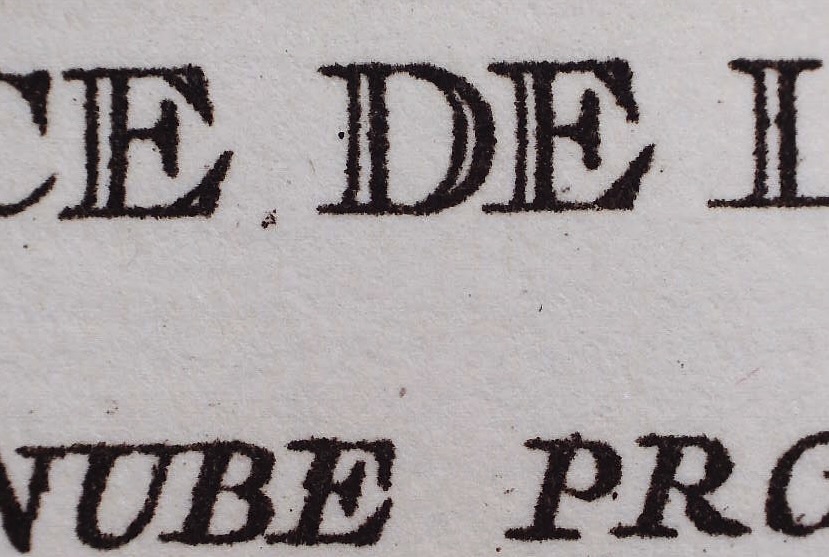
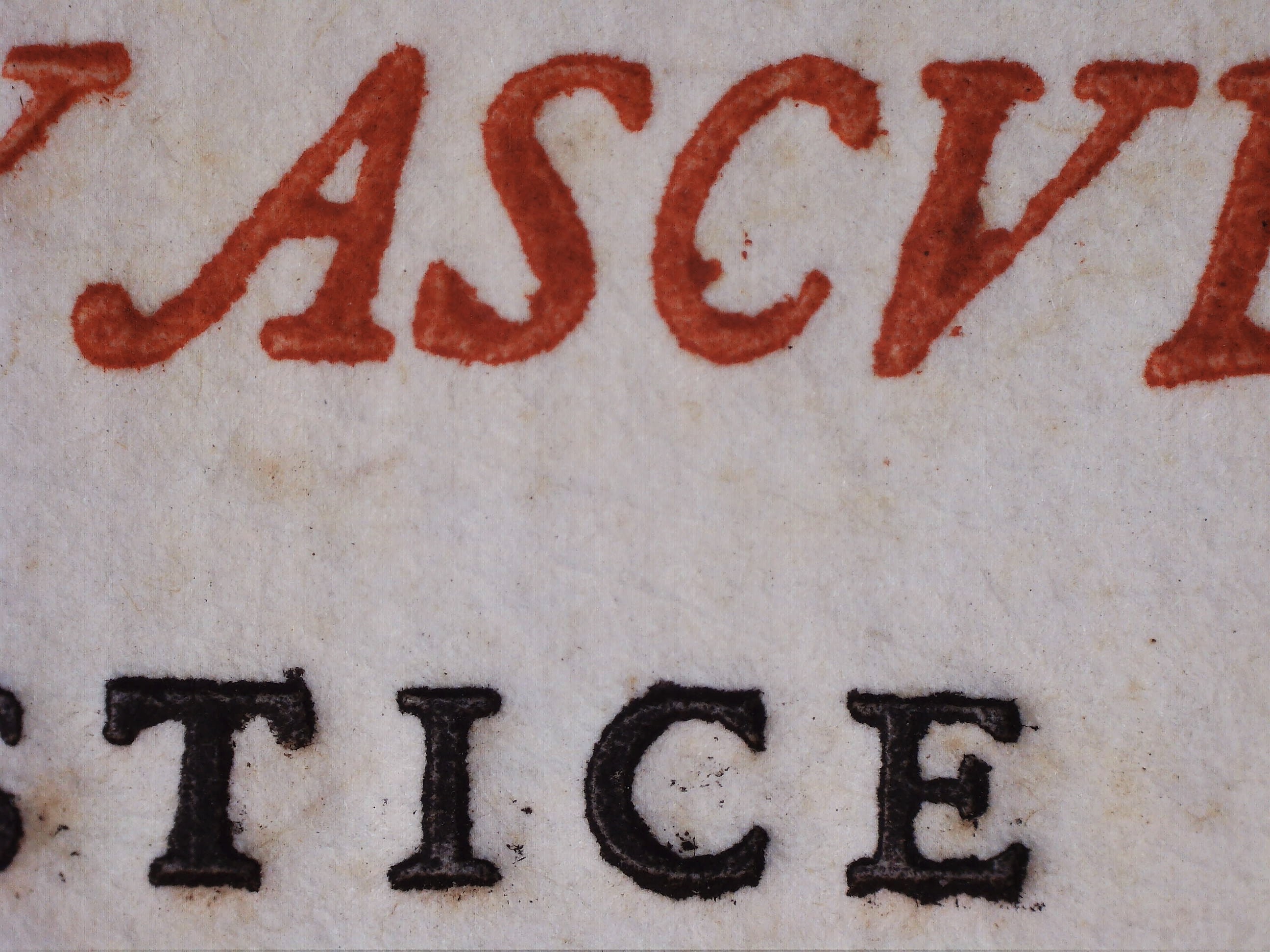
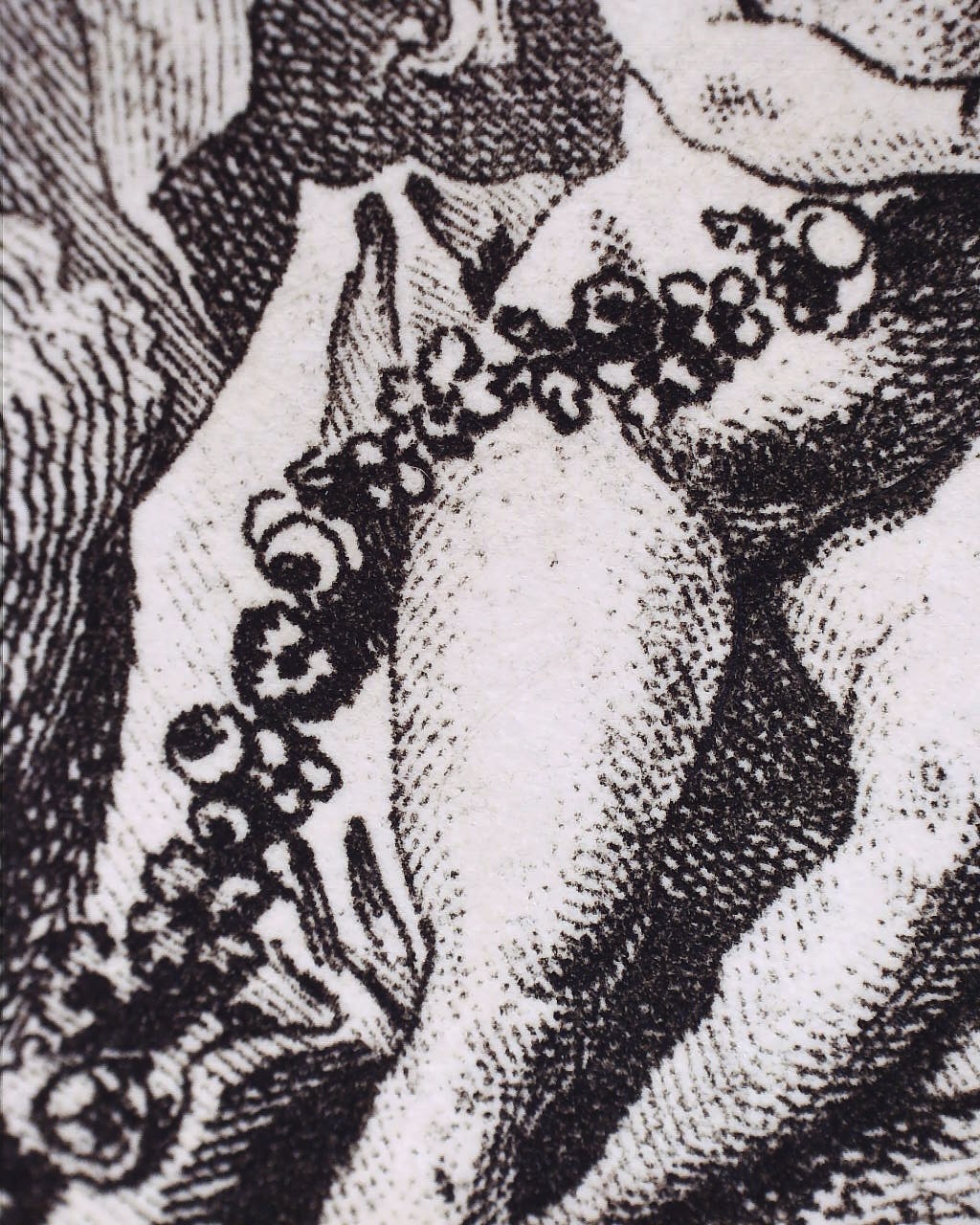
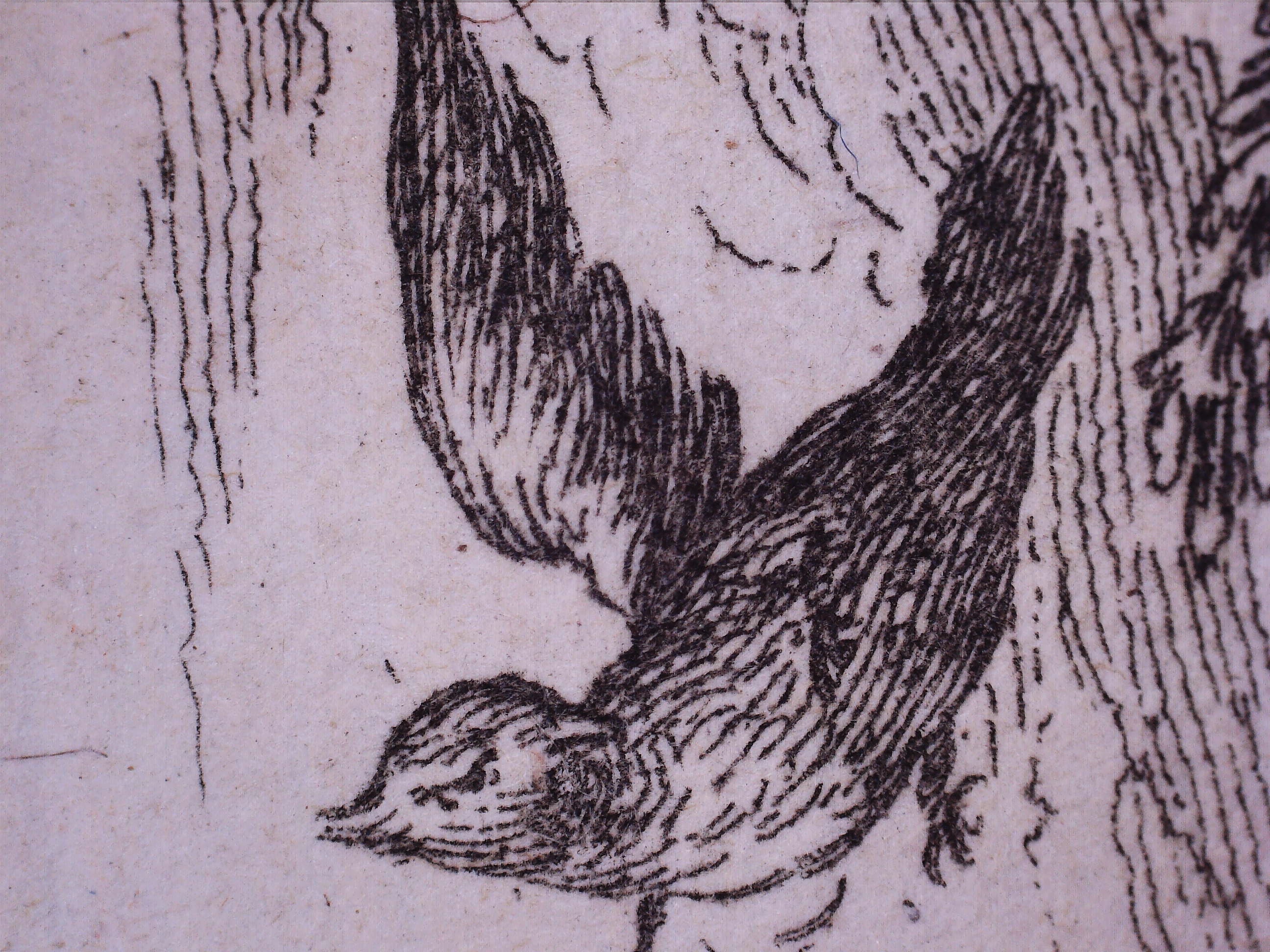
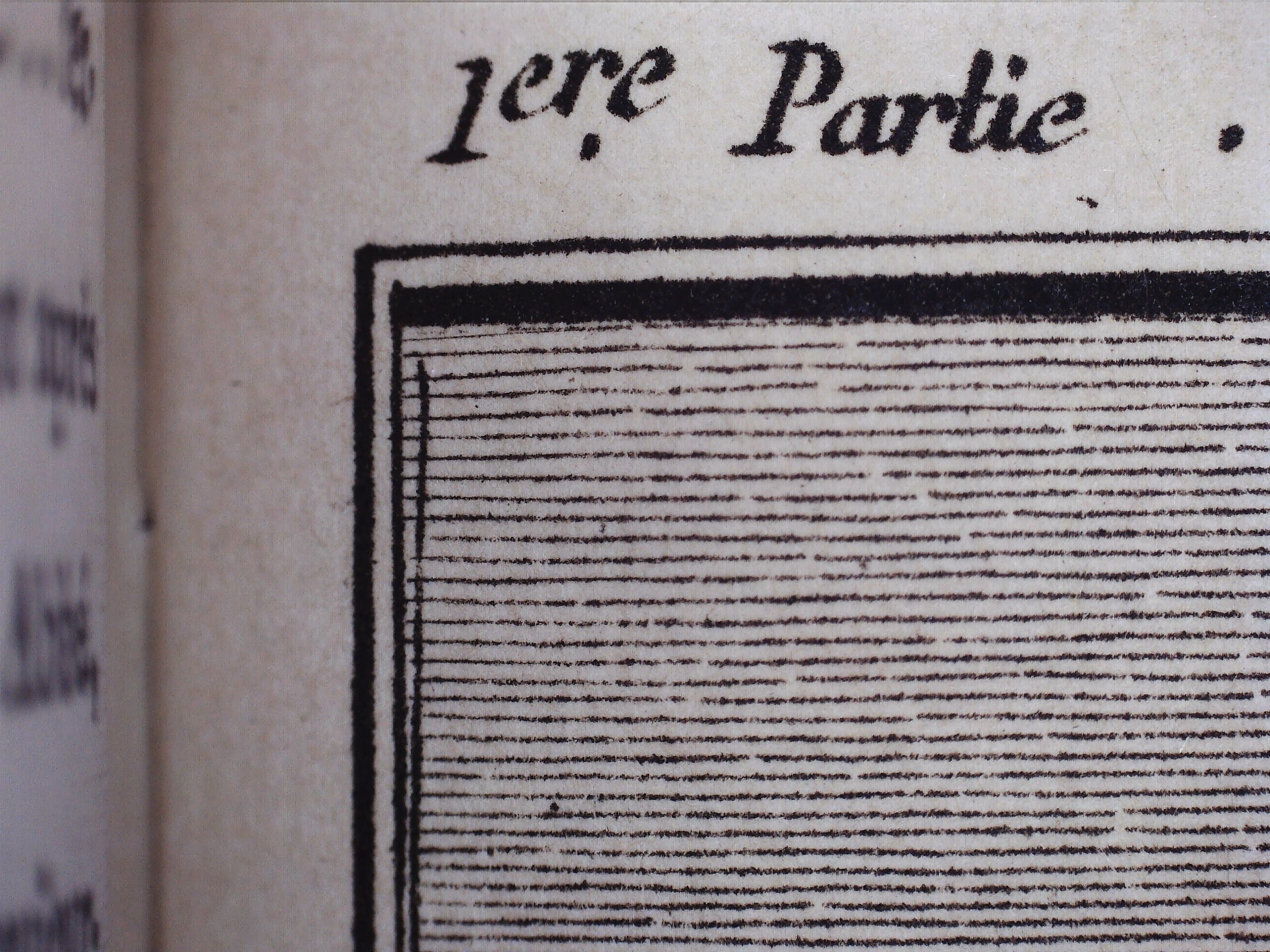
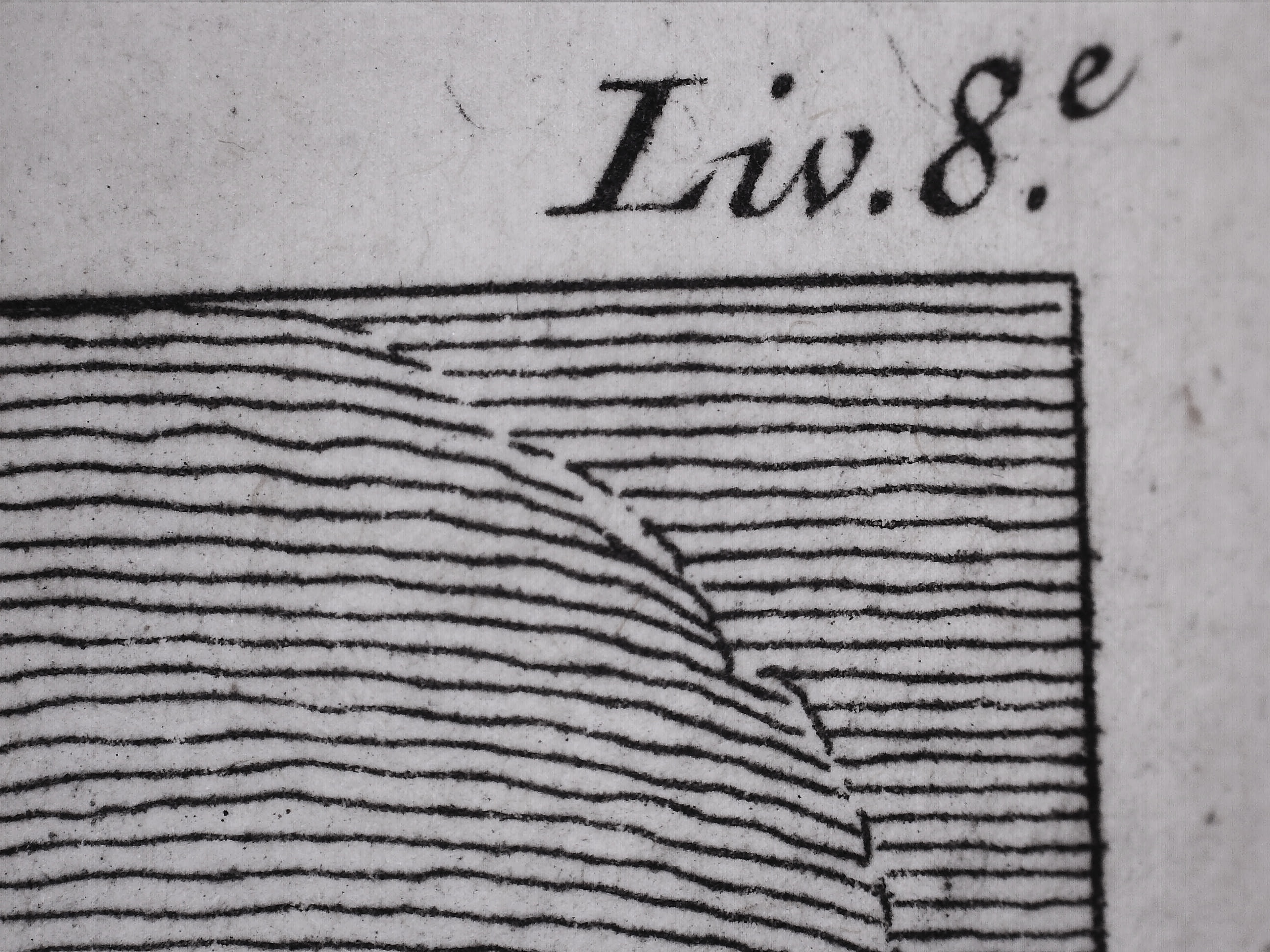
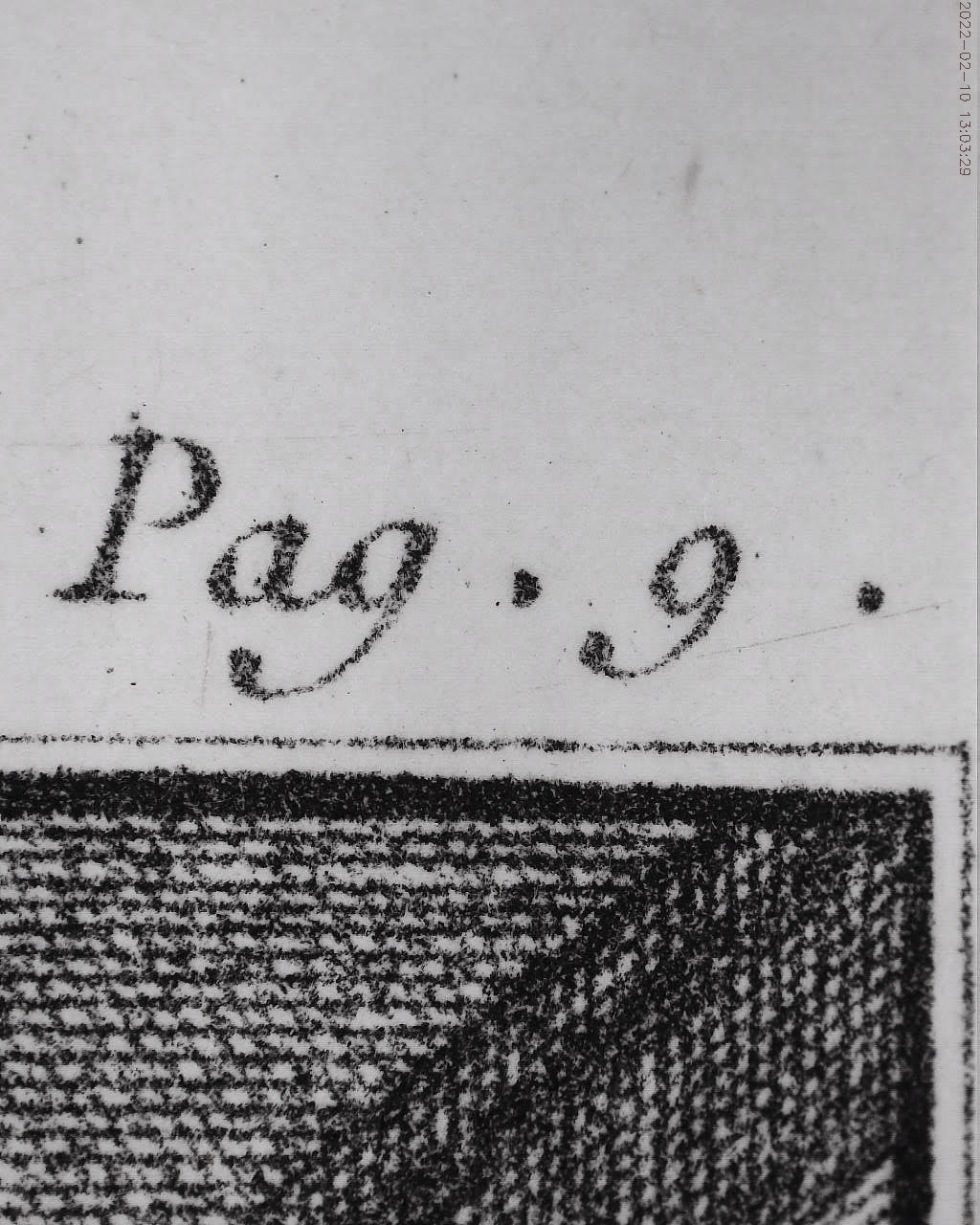
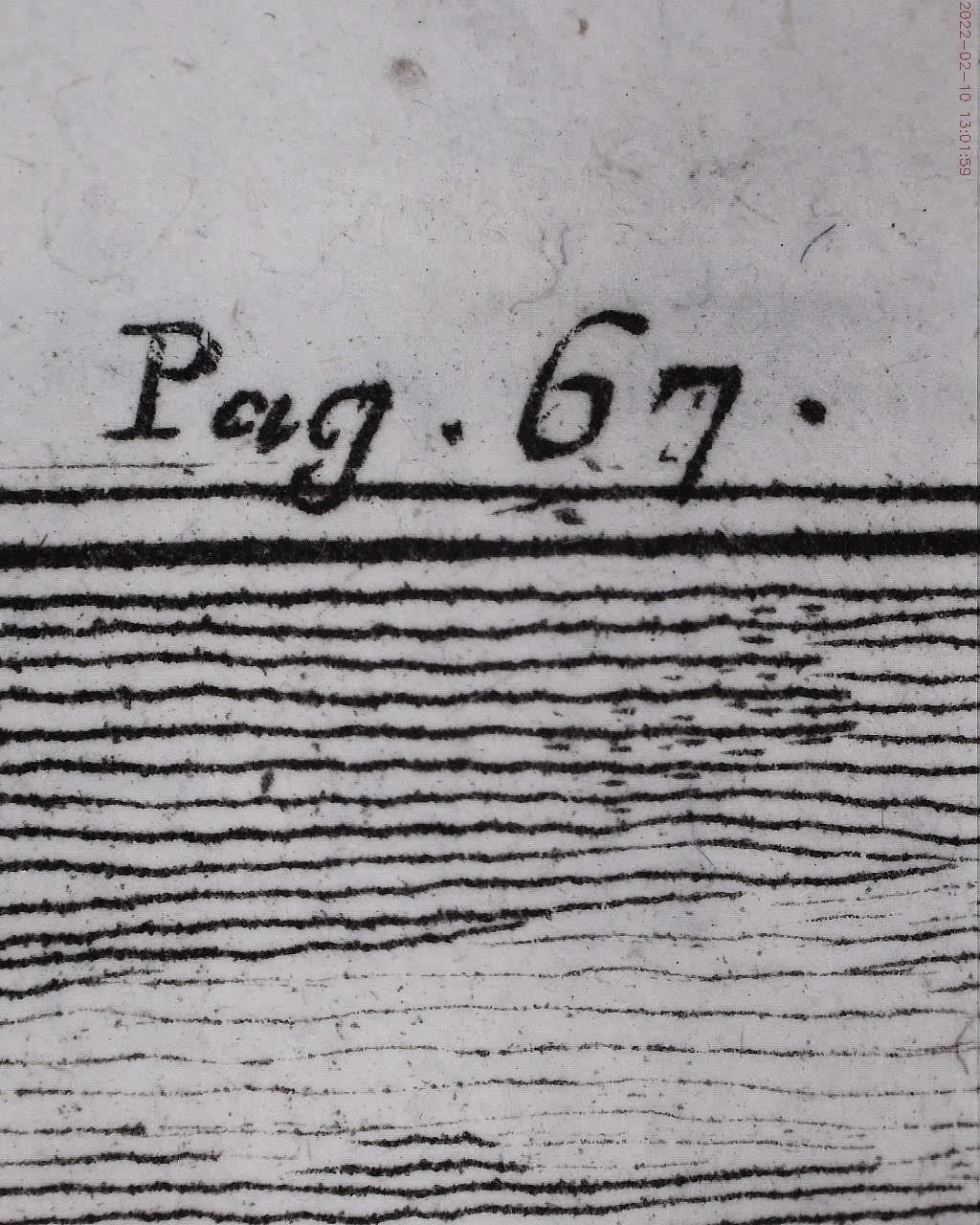

-
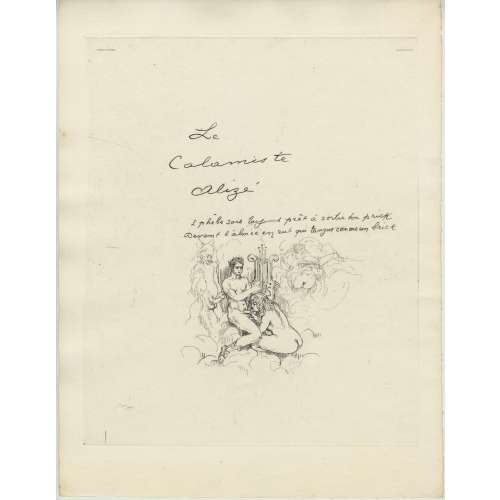 Thirteen unnumbered loose leaves 323 x 249 mm, watermarked BFK Rives, with manuscript text and vignettes produced by etching or, more likely, drypoint (see microphoto), incl. title-page, one full-page illustration and two leaves of text only; versos blank. Some leaves have registration marks. The set is housed in a cream French flapped folder (chemise) without lettering; the seller’s description is pasted to the front cover verso, glassine dust cover. Seller’s description: Cette édition in-folio du recueil de poèmes de Louis de Gonzague Frick, inconnue de Jean-Pierre Dutel, qui « a été tirée à 50 exemplaires (...) est certainement la plus rare (et a été) publiée après 1940 sur vélin (BFK) Rives » (cf. Ader, 3 mars 2020, n°155). Exemplaire « de passe », sans justificatif, complet des 13 planches avec 11 eaux-fortes, dont une à pleine page, d'Auguste Brouet. Ref.: According to honesterotica, the first edition was published in 1938 in 65 copies: "The pink Ingres paper and the loose-leaf format tied with a red ribbon". Another source states: "Le tirage a été effectué avec marges, sur papier vélin BFK Rives au format in-4 (32,5 × 25), les planches mesurant 26,5 × 22 cm. Certains exemplaires sont sur papier blanc - Je remercie le libraire qui a pris la peine de me communiquer ces dernières informations. Pour moi, c'est bien l'édition à 65 qui est l'originale, les deux autres étant des retirages légèrement postérieurs, mais dans le détail desquels le principe de l’œuvre - un manuscrit destiné à quelques amis de l'auteur - a été quelque peu trahi." Contributors: Louis de Gonzague Frick (French, 1883 – 1958) Auguste Brouet (French, 1872 – 1941)
Thirteen unnumbered loose leaves 323 x 249 mm, watermarked BFK Rives, with manuscript text and vignettes produced by etching or, more likely, drypoint (see microphoto), incl. title-page, one full-page illustration and two leaves of text only; versos blank. Some leaves have registration marks. The set is housed in a cream French flapped folder (chemise) without lettering; the seller’s description is pasted to the front cover verso, glassine dust cover. Seller’s description: Cette édition in-folio du recueil de poèmes de Louis de Gonzague Frick, inconnue de Jean-Pierre Dutel, qui « a été tirée à 50 exemplaires (...) est certainement la plus rare (et a été) publiée après 1940 sur vélin (BFK) Rives » (cf. Ader, 3 mars 2020, n°155). Exemplaire « de passe », sans justificatif, complet des 13 planches avec 11 eaux-fortes, dont une à pleine page, d'Auguste Brouet. Ref.: According to honesterotica, the first edition was published in 1938 in 65 copies: "The pink Ingres paper and the loose-leaf format tied with a red ribbon". Another source states: "Le tirage a été effectué avec marges, sur papier vélin BFK Rives au format in-4 (32,5 × 25), les planches mesurant 26,5 × 22 cm. Certains exemplaires sont sur papier blanc - Je remercie le libraire qui a pris la peine de me communiquer ces dernières informations. Pour moi, c'est bien l'édition à 65 qui est l'originale, les deux autres étant des retirages légèrement postérieurs, mais dans le détail desquels le principe de l’œuvre - un manuscrit destiné à quelques amis de l'auteur - a été quelque peu trahi." Contributors: Louis de Gonzague Frick (French, 1883 – 1958) Auguste Brouet (French, 1872 – 1941) -
 Colour (tone) lithography, image 396 x 508 mm, sheet 532 x 654 mm; before signature, undated; pencil ms inscription: Föhrenhain — E. Pelikan / 200M to the lower-right corner of the sheet. Contributor: Emilie Mediz-Pelikan (Austrian, 1861 – 1908) – artist. Seller's description: Austrian-German painter and graphic artist. Emilie Mediz-Pelikan was born in Vöcklabruck in 1861. She studied at the Vienna Academy and followed her teacher Albert Zimmermann to Salzburg and in 1885 to Munich. In 1891 she married the painter and graphic artist Karl Mediz (1868 - 1945), with whom she lived in Vienna and from 1894 in Dresden. She was in contact with the Dachau Artists' Colony and went on study trips to Paris, Belgium, Hungary and Italy. In the Dachau artists' colony she was friends with Adolf Hölzel and Fritz von Uhde. In 1889 and 1890 she spent time in Paris and in the Belgian artists' colony Knokke. In 1898 she was represented at the first art exhibition of the Vienna Secession, and in 1901 at the International Art Exhibition in Dresden. In 1903 she and her husband had a group exhibition, at the Hagenbund in Vienna. In 1904, she showed graphic works at the Dresden royal court art dealer Richter, and in 1905 and 1906 she exhibited at the Berlin Künstlerhaus. It was not until around 1900 that she achieved her artistic breakthrough with her landscape paintings. Since the estate of the artist, who died prematurely in Dresden in 1908, was lost in the former GDR until the 1980s, it was quite late that the artist was rediscovered and revalued both in Austrian art history and on the art market. In 1986, the first major exhibitions took place at the Upper Austrian State Museum and the University of Applied Arts in Vienna, followed by numerous smaller exhibitions in private galleries in Vienna, Linz and Munich. The artist received recognition during her lifetime from numerous prominent fellow painters as well as from the art critic Ludwig Hevesi. Together with Tina Blau, Herbert Boeckl, Marie Egner, Theodor von Hörmann, Franz Jaschke, Eugen Jettel, Ludwig Heinrich Jungnickel, Rudolf Junk, Gustav Klimt, Oskar Kokoschka, Johann Victor Krämer, Heinrich Kühn, Carl Moll, Rudolf Quittner, Rudolf Ribarz, Emil Jakob Schindler, Max Suppantschitsch, Max Weiler, Olga Wisinger-Florian and Alfred Zoff, she was a protagonist of the reception of Impressionism in Austria. This style went down in Austrian art history under the term "Stimmungsimpressionismus".
Colour (tone) lithography, image 396 x 508 mm, sheet 532 x 654 mm; before signature, undated; pencil ms inscription: Föhrenhain — E. Pelikan / 200M to the lower-right corner of the sheet. Contributor: Emilie Mediz-Pelikan (Austrian, 1861 – 1908) – artist. Seller's description: Austrian-German painter and graphic artist. Emilie Mediz-Pelikan was born in Vöcklabruck in 1861. She studied at the Vienna Academy and followed her teacher Albert Zimmermann to Salzburg and in 1885 to Munich. In 1891 she married the painter and graphic artist Karl Mediz (1868 - 1945), with whom she lived in Vienna and from 1894 in Dresden. She was in contact with the Dachau Artists' Colony and went on study trips to Paris, Belgium, Hungary and Italy. In the Dachau artists' colony she was friends with Adolf Hölzel and Fritz von Uhde. In 1889 and 1890 she spent time in Paris and in the Belgian artists' colony Knokke. In 1898 she was represented at the first art exhibition of the Vienna Secession, and in 1901 at the International Art Exhibition in Dresden. In 1903 she and her husband had a group exhibition, at the Hagenbund in Vienna. In 1904, she showed graphic works at the Dresden royal court art dealer Richter, and in 1905 and 1906 she exhibited at the Berlin Künstlerhaus. It was not until around 1900 that she achieved her artistic breakthrough with her landscape paintings. Since the estate of the artist, who died prematurely in Dresden in 1908, was lost in the former GDR until the 1980s, it was quite late that the artist was rediscovered and revalued both in Austrian art history and on the art market. In 1986, the first major exhibitions took place at the Upper Austrian State Museum and the University of Applied Arts in Vienna, followed by numerous smaller exhibitions in private galleries in Vienna, Linz and Munich. The artist received recognition during her lifetime from numerous prominent fellow painters as well as from the art critic Ludwig Hevesi. Together with Tina Blau, Herbert Boeckl, Marie Egner, Theodor von Hörmann, Franz Jaschke, Eugen Jettel, Ludwig Heinrich Jungnickel, Rudolf Junk, Gustav Klimt, Oskar Kokoschka, Johann Victor Krämer, Heinrich Kühn, Carl Moll, Rudolf Quittner, Rudolf Ribarz, Emil Jakob Schindler, Max Suppantschitsch, Max Weiler, Olga Wisinger-Florian and Alfred Zoff, she was a protagonist of the reception of Impressionism in Austria. This style went down in Austrian art history under the term "Stimmungsimpressionismus". -
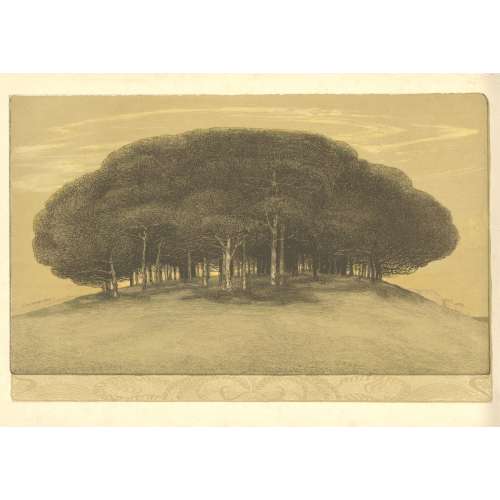 Colour (tone) lithography, image 268 x 410 mm, sheet 317 x 470 mm; signed on bottom-left of the image “Pelikan 1905”, and pencil ms inscription: E. Pelikan to the lower-right corner of the sheet. Contributor: Emilie Mediz-Pelikan (Austrian, 1861 – 1908) – artist. Seller's description: Austrian-German painter and graphic artist. Emilie Mediz-Pelikan was born in Vöcklabruck in 1861. She studied at the Vienna Academy and followed her teacher Albert Zimmermann to Salzburg and in 1885 to Munich. In 1891 she married the painter and graphic artist Karl Mediz (1868 - 1945), with whom she lived in Vienna and from 1894 in Dresden. She was in contact with the Dachau Artists' Colony and went on study trips to Paris, Belgium, Hungary and Italy. In the Dachau artists' colony she was friends with Adolf Hölzel and Fritz von Uhde. In 1889 and 1890 she spent time in Paris and in the Belgian artists' colony Knokke. In 1898 she was represented at the first art exhibition of the Vienna Secession, and in 1901 at the International Art Exhibition in Dresden. In 1903 she and her husband had a group exhibition, at the Hagenbund in Vienna. In 1904, she showed graphic works at the Dresden royal court art dealer Richter, and in 1905 and 1906 she exhibited at the Berlin Künstlerhaus. It was not until around 1900 that she achieved her artistic breakthrough with her landscape paintings. Since the estate of the artist, who died prematurely in Dresden in 1908, was lost in the former GDR until the 1980s, it was quite late that the artist was rediscovered and revalued both in Austrian art history and on the art market. In 1986, the first major exhibitions took place at the Upper Austrian State Museum and the University of Applied Arts in Vienna, followed by numerous smaller exhibitions in private galleries in Vienna, Linz and Munich. The artist received recognition during her lifetime from numerous prominent fellow painters as well as from the art critic Ludwig Hevesi. Together with Tina Blau, Herbert Boeckl, Marie Egner, Theodor von Hörmann, Franz Jaschke, Eugen Jettel, Ludwig Heinrich Jungnickel, Rudolf Junk, Gustav Klimt, Oskar Kokoschka, Johann Victor Krämer, Heinrich Kühn, Carl Moll, Rudolf Quittner, Rudolf Ribarz, Emil Jakob Schindler, Max Suppantschitsch, Max Weiler, Olga Wisinger-Florian and Alfred Zoff, she was a protagonist of the reception of Impressionism in Austria. This style went down in Austrian art history under the term "Stimmungsimpressionismus".
Colour (tone) lithography, image 268 x 410 mm, sheet 317 x 470 mm; signed on bottom-left of the image “Pelikan 1905”, and pencil ms inscription: E. Pelikan to the lower-right corner of the sheet. Contributor: Emilie Mediz-Pelikan (Austrian, 1861 – 1908) – artist. Seller's description: Austrian-German painter and graphic artist. Emilie Mediz-Pelikan was born in Vöcklabruck in 1861. She studied at the Vienna Academy and followed her teacher Albert Zimmermann to Salzburg and in 1885 to Munich. In 1891 she married the painter and graphic artist Karl Mediz (1868 - 1945), with whom she lived in Vienna and from 1894 in Dresden. She was in contact with the Dachau Artists' Colony and went on study trips to Paris, Belgium, Hungary and Italy. In the Dachau artists' colony she was friends with Adolf Hölzel and Fritz von Uhde. In 1889 and 1890 she spent time in Paris and in the Belgian artists' colony Knokke. In 1898 she was represented at the first art exhibition of the Vienna Secession, and in 1901 at the International Art Exhibition in Dresden. In 1903 she and her husband had a group exhibition, at the Hagenbund in Vienna. In 1904, she showed graphic works at the Dresden royal court art dealer Richter, and in 1905 and 1906 she exhibited at the Berlin Künstlerhaus. It was not until around 1900 that she achieved her artistic breakthrough with her landscape paintings. Since the estate of the artist, who died prematurely in Dresden in 1908, was lost in the former GDR until the 1980s, it was quite late that the artist was rediscovered and revalued both in Austrian art history and on the art market. In 1986, the first major exhibitions took place at the Upper Austrian State Museum and the University of Applied Arts in Vienna, followed by numerous smaller exhibitions in private galleries in Vienna, Linz and Munich. The artist received recognition during her lifetime from numerous prominent fellow painters as well as from the art critic Ludwig Hevesi. Together with Tina Blau, Herbert Boeckl, Marie Egner, Theodor von Hörmann, Franz Jaschke, Eugen Jettel, Ludwig Heinrich Jungnickel, Rudolf Junk, Gustav Klimt, Oskar Kokoschka, Johann Victor Krämer, Heinrich Kühn, Carl Moll, Rudolf Quittner, Rudolf Ribarz, Emil Jakob Schindler, Max Suppantschitsch, Max Weiler, Olga Wisinger-Florian and Alfred Zoff, she was a protagonist of the reception of Impressionism in Austria. This style went down in Austrian art history under the term "Stimmungsimpressionismus". -
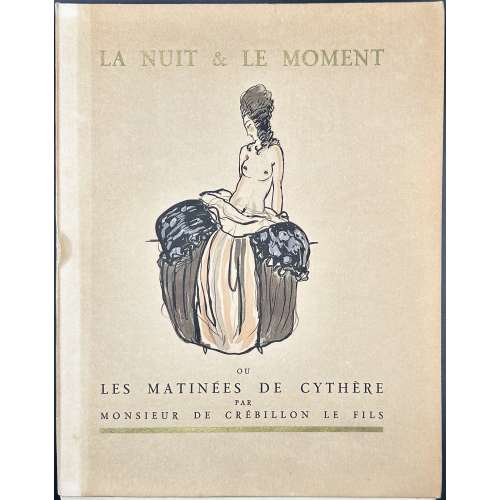 Softcover volume, 33 x 26 cm, collated in folio, not bound, in publisher’s French flapped pictorial wrappers, lettering to spine; printed on thick wove Arches paper watermarked “MBM”, upper edge trimmed, owner’s blind stamp to h.t. “Ex Libris Comte Tony de Vibraye”, glassine dust jacket, in a slipcase. Collation: π2 1-262, total 54 leaves, plus 4 leaves in wrappers, plus 10 plates, incl. frontispiece; coloured aquatints after Sylvain Sauvage; coloured etched vignette to front wrapper, gilt woodcut to back wrapper, woodcut title-page and woodcut headpiece after the same. Pp.: [4] [1] 2-102 [2]. Front wrapper (gilt and black): LA NUIT & LE MOMENT | {vignette} | OU | LES MATINÉES DE CYTHÈRE | PAR | MONSIEUR DE CRÉBILLON LE FILS | — || Title-page (woodcut): CRÉBILLON LE FILS | — | LA NUIT ET LE MOMENT | OU | LES MATINÉES | DE CYTHÈRE | {vignette} | A PARIS | AUX DEPENS D'UN AMATEUR | — | M CM XXIV || Limitation: De cette édition il a été tiré un exemplaire unique sur japon impérial comportant dix aquarelles originales, deux cents trente exemplaires sur vélin d' Arches numérotés 1 à 230, dont les dix premiers avec une suite de hors texte sur japon. N° 1 [Print run limited to 230 copies on Arches plus a unique copy on Japon with original watercolours, this is copy № 1 on wove paper]. Seller’s description: La Nuit et le moment ou Les Matinées de Cythère. Paris, Au dépens d'un amateur, 1924. In-4, en feuilles, non rogné, couverture illustrée et étui. Ouvrage illustré de 4 gravures sur bois et de 10 eaux-fortes libres en couleurs hors texte de Sylvain Sauvage. Tirage à 231 exemplaires, celui-ci le n°1 sur vélin d'Arches. Manque la suite de hors texte sur japon. De la bibliothèque du Comte Tony de Vibraye, avec cachet à froid. Dutel, n°2062. Catalogue raisonné: honesterotica.com; Dutel III 2062. Contributors: Claude-Prosper Jolyot de Crébillon [Crébillon fils] (French, 1707 – 1777) – author. Sylvain Sauvage [Félix Roy] (French, 1888 – 1948) – artist. Provenance: Antoine Henri Gaston Hurault de Vibraye [Comte Tony de Vibraye] (French, 1893 – 1951)
Softcover volume, 33 x 26 cm, collated in folio, not bound, in publisher’s French flapped pictorial wrappers, lettering to spine; printed on thick wove Arches paper watermarked “MBM”, upper edge trimmed, owner’s blind stamp to h.t. “Ex Libris Comte Tony de Vibraye”, glassine dust jacket, in a slipcase. Collation: π2 1-262, total 54 leaves, plus 4 leaves in wrappers, plus 10 plates, incl. frontispiece; coloured aquatints after Sylvain Sauvage; coloured etched vignette to front wrapper, gilt woodcut to back wrapper, woodcut title-page and woodcut headpiece after the same. Pp.: [4] [1] 2-102 [2]. Front wrapper (gilt and black): LA NUIT & LE MOMENT | {vignette} | OU | LES MATINÉES DE CYTHÈRE | PAR | MONSIEUR DE CRÉBILLON LE FILS | — || Title-page (woodcut): CRÉBILLON LE FILS | — | LA NUIT ET LE MOMENT | OU | LES MATINÉES | DE CYTHÈRE | {vignette} | A PARIS | AUX DEPENS D'UN AMATEUR | — | M CM XXIV || Limitation: De cette édition il a été tiré un exemplaire unique sur japon impérial comportant dix aquarelles originales, deux cents trente exemplaires sur vélin d' Arches numérotés 1 à 230, dont les dix premiers avec une suite de hors texte sur japon. N° 1 [Print run limited to 230 copies on Arches plus a unique copy on Japon with original watercolours, this is copy № 1 on wove paper]. Seller’s description: La Nuit et le moment ou Les Matinées de Cythère. Paris, Au dépens d'un amateur, 1924. In-4, en feuilles, non rogné, couverture illustrée et étui. Ouvrage illustré de 4 gravures sur bois et de 10 eaux-fortes libres en couleurs hors texte de Sylvain Sauvage. Tirage à 231 exemplaires, celui-ci le n°1 sur vélin d'Arches. Manque la suite de hors texte sur japon. De la bibliothèque du Comte Tony de Vibraye, avec cachet à froid. Dutel, n°2062. Catalogue raisonné: honesterotica.com; Dutel III 2062. Contributors: Claude-Prosper Jolyot de Crébillon [Crébillon fils] (French, 1707 – 1777) – author. Sylvain Sauvage [Félix Roy] (French, 1888 – 1948) – artist. Provenance: Antoine Henri Gaston Hurault de Vibraye [Comte Tony de Vibraye] (French, 1893 – 1951)


